Redesign of Business Process for the Development of Document Management System
VerifiedAdded on 2023/04/10
|31
|10037
|432
AI Summary
This thesis aims to develop, re-engineer and improve the case company’s Document Management system Processes by applying business process improvement and business process re-engineering and design methodologies. The methodology includes current processes description and monitoring, identification of non-value-adding activities and main problems, solutions proposal and documentation, and evaluation of gains due to the implementation of the proposed redesigned processes. The study focuses on business process improvement and re-engineering of administrational processes, with a specific focus on the case company’s existing Document Management Process. The results show how the document management Process was developed, re-engineered and improved to establish better efficiency, accountability, and consistency within the organization.
Contribute Materials
Your contribution can guide someone’s learning journey. Share your
documents today.
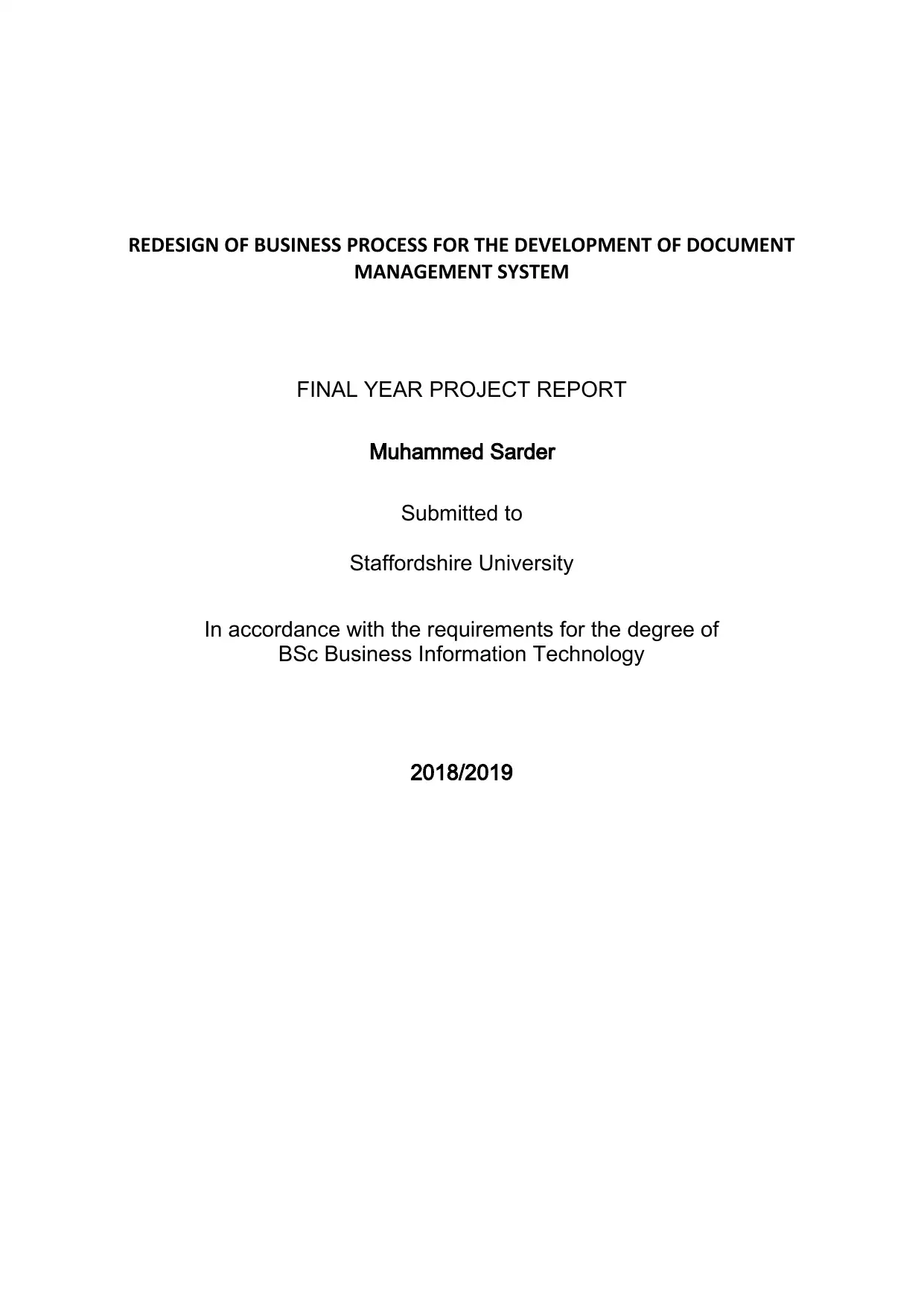
REDESIGN OF BUSINESS PROCESS FOR THE DEVELOPMENT OF DOCUMENT
MANAGEMENT SYSTEM
FINAL YEAR PROJECT REPORT
Muhammed Sarder
Submitted to
Staffordshire University
In accordance with the requirements for the degree of
BSc Business Information Technology
2018/2019
MANAGEMENT SYSTEM
FINAL YEAR PROJECT REPORT
Muhammed Sarder
Submitted to
Staffordshire University
In accordance with the requirements for the degree of
BSc Business Information Technology
2018/2019
Secure Best Marks with AI Grader
Need help grading? Try our AI Grader for instant feedback on your assignments.
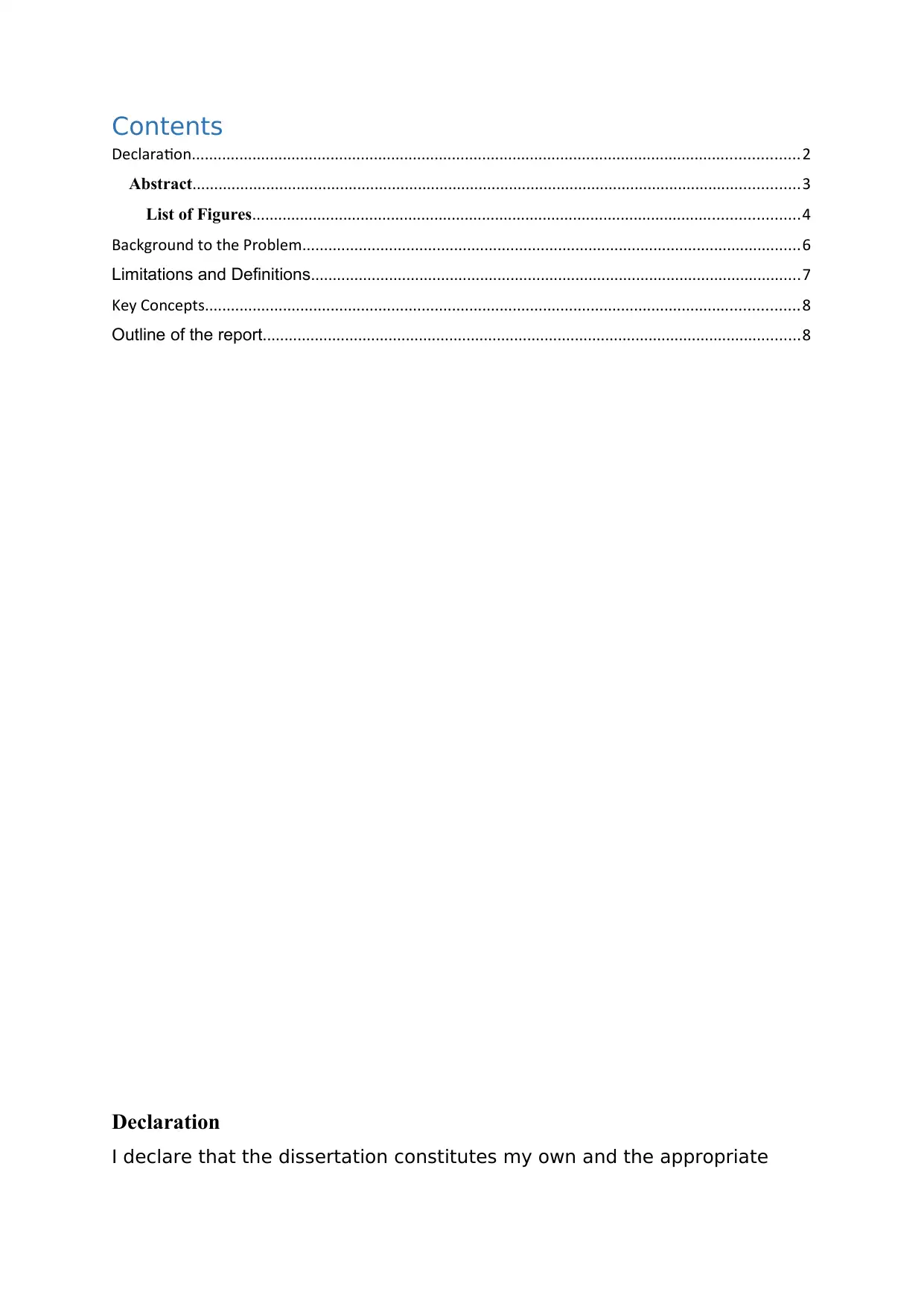
Contents
Declaration............................................................................................................................................2
Abstract............................................................................................................................................3
List of Figures..............................................................................................................................4
Background to the Problem...................................................................................................................6
Limitations and Definitions.................................................................................................................7
Key Concepts.........................................................................................................................................8
Outline of the report............................................................................................................................8
Declaration
I declare that the dissertation constitutes my own and the appropriate
Declaration............................................................................................................................................2
Abstract............................................................................................................................................3
List of Figures..............................................................................................................................4
Background to the Problem...................................................................................................................6
Limitations and Definitions.................................................................................................................7
Key Concepts.........................................................................................................................................8
Outline of the report............................................................................................................................8
Declaration
I declare that the dissertation constitutes my own and the appropriate
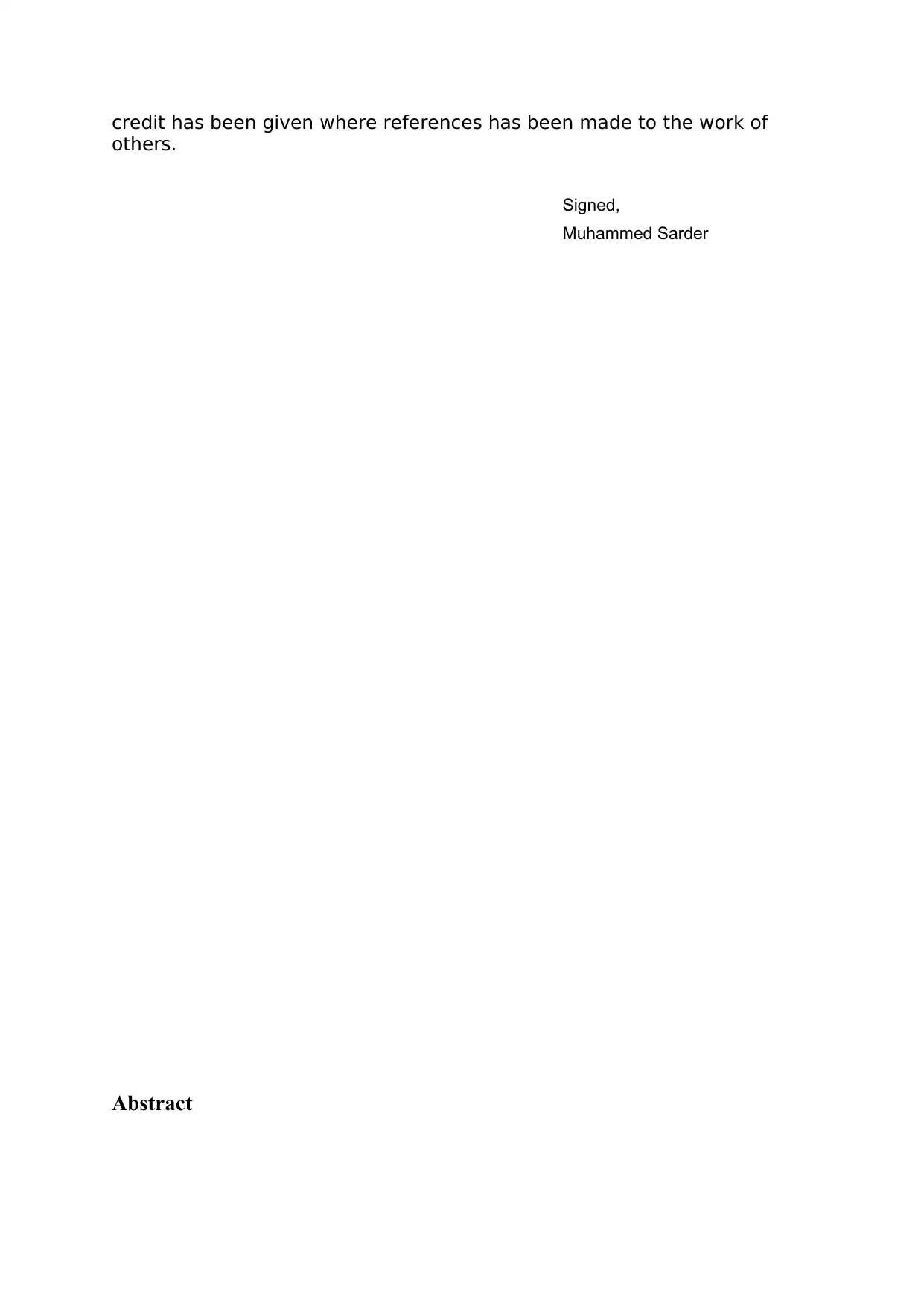
credit has been given where references has been made to the work of
others.
Signed,
Muhammed Sarder
Abstract
others.
Signed,
Muhammed Sarder
Abstract
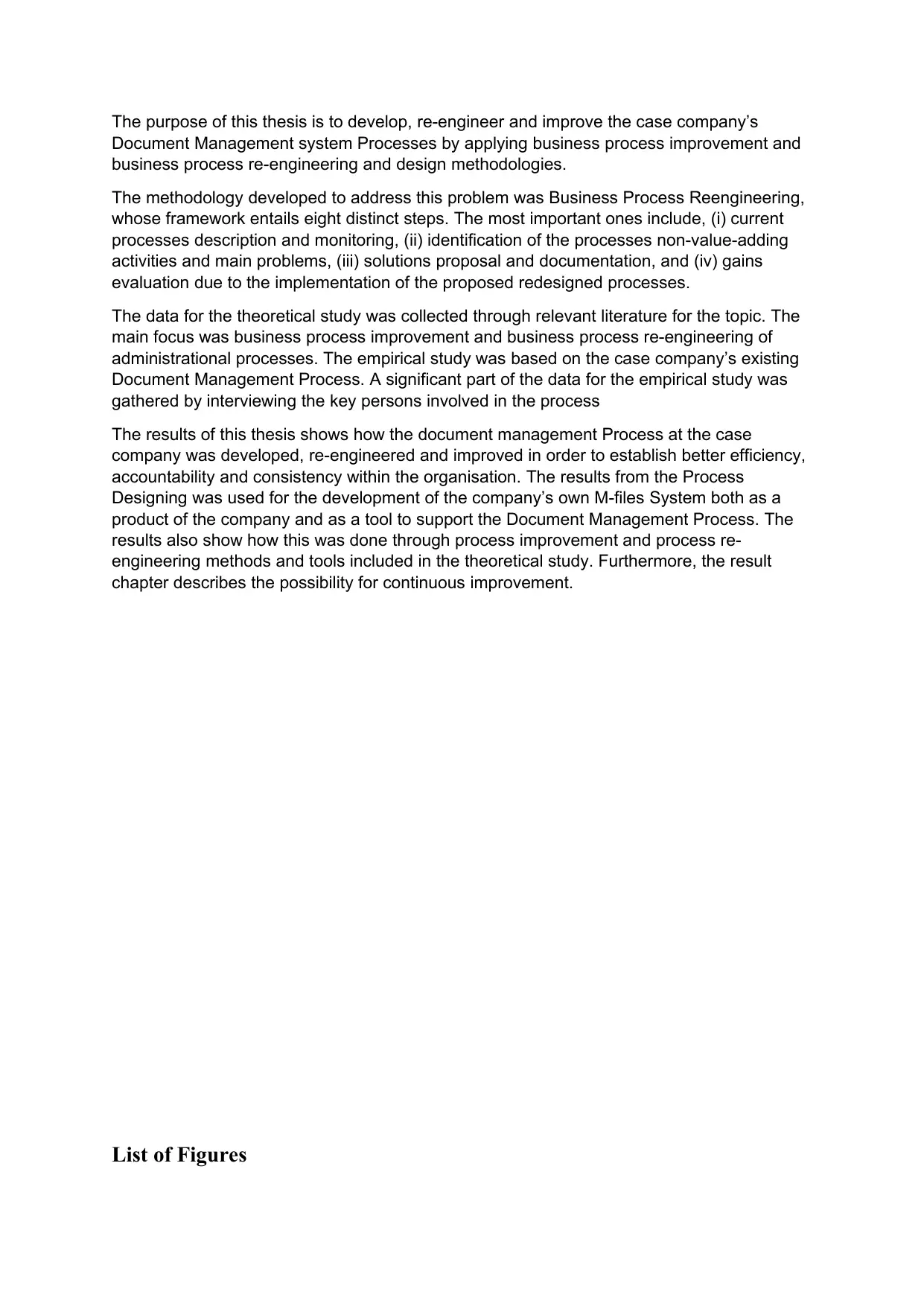
The purpose of this thesis is to develop, re-engineer and improve the case company’s
Document Management system Processes by applying business process improvement and
business process re-engineering and design methodologies.
The methodology developed to address this problem was Business Process Reengineering,
whose framework entails eight distinct steps. The most important ones include, (i) current
processes description and monitoring, (ii) identification of the processes non-value-adding
activities and main problems, (iii) solutions proposal and documentation, and (iv) gains
evaluation due to the implementation of the proposed redesigned processes.
The data for the theoretical study was collected through relevant literature for the topic. The
main focus was business process improvement and business process re-engineering of
administrational processes. The empirical study was based on the case company’s existing
Document Management Process. A significant part of the data for the empirical study was
gathered by interviewing the key persons involved in the process
The results of this thesis shows how the document management Process at the case
company was developed, re-engineered and improved in order to establish better efficiency,
accountability and consistency within the organisation. The results from the Process
Designing was used for the development of the company’s own M-files System both as a
product of the company and as a tool to support the Document Management Process. The
results also show how this was done through process improvement and process re-
engineering methods and tools included in the theoretical study. Furthermore, the result
chapter describes the possibility for continuous improvement.
List of Figures
Document Management system Processes by applying business process improvement and
business process re-engineering and design methodologies.
The methodology developed to address this problem was Business Process Reengineering,
whose framework entails eight distinct steps. The most important ones include, (i) current
processes description and monitoring, (ii) identification of the processes non-value-adding
activities and main problems, (iii) solutions proposal and documentation, and (iv) gains
evaluation due to the implementation of the proposed redesigned processes.
The data for the theoretical study was collected through relevant literature for the topic. The
main focus was business process improvement and business process re-engineering of
administrational processes. The empirical study was based on the case company’s existing
Document Management Process. A significant part of the data for the empirical study was
gathered by interviewing the key persons involved in the process
The results of this thesis shows how the document management Process at the case
company was developed, re-engineered and improved in order to establish better efficiency,
accountability and consistency within the organisation. The results from the Process
Designing was used for the development of the company’s own M-files System both as a
product of the company and as a tool to support the Document Management Process. The
results also show how this was done through process improvement and process re-
engineering methods and tools included in the theoretical study. Furthermore, the result
chapter describes the possibility for continuous improvement.
List of Figures
Secure Best Marks with AI Grader
Need help grading? Try our AI Grader for instant feedback on your assignments.
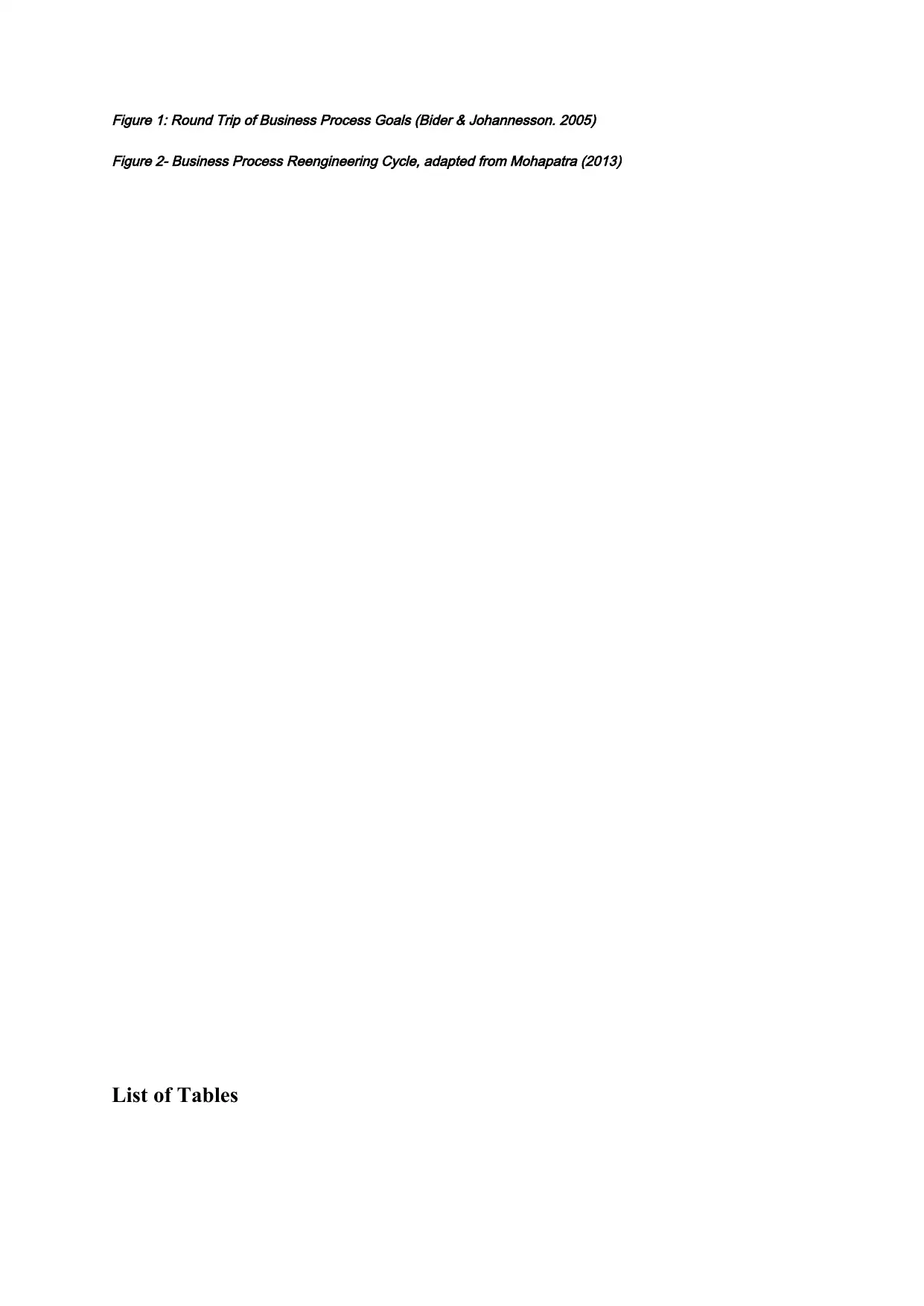
Figure 1: Round Trip of Business Process Goals (Bider & Johannesson. 2005)
Figure 2- Business Process Reengineering Cycle, adapted from Mohapatra (2013)
List of Tables
Figure 2- Business Process Reengineering Cycle, adapted from Mohapatra (2013)
List of Tables
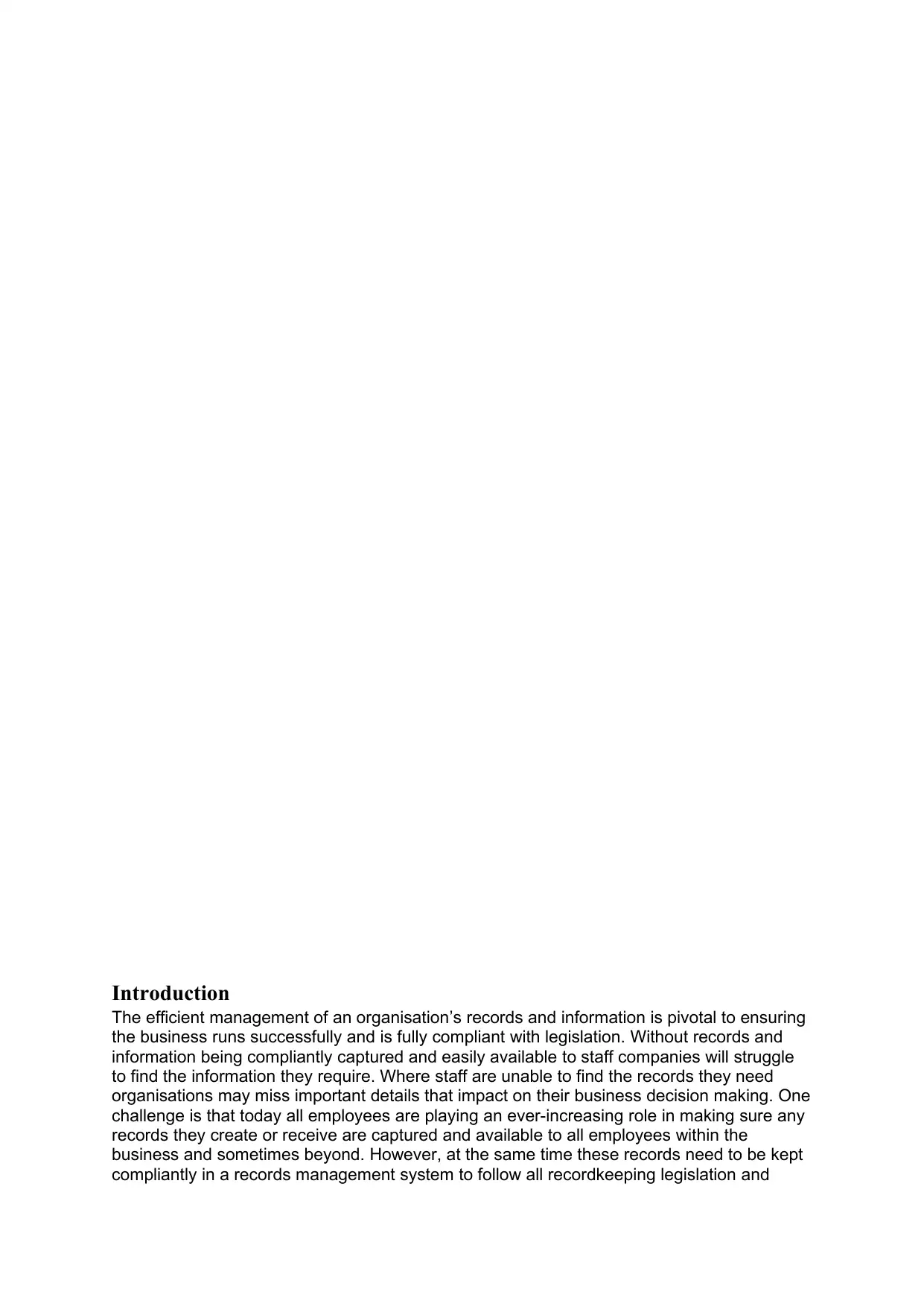
Introduction
The efficient management of an organisation’s records and information is pivotal to ensuring
the business runs successfully and is fully compliant with legislation. Without records and
information being compliantly captured and easily available to staff companies will struggle
to find the information they require. Where staff are unable to find the records they need
organisations may miss important details that impact on their business decision making. One
challenge is that today all employees are playing an ever-increasing role in making sure any
records they create or receive are captured and available to all employees within the
business and sometimes beyond. However, at the same time these records need to be kept
compliantly in a records management system to follow all recordkeeping legislation and
The efficient management of an organisation’s records and information is pivotal to ensuring
the business runs successfully and is fully compliant with legislation. Without records and
information being compliantly captured and easily available to staff companies will struggle
to find the information they require. Where staff are unable to find the records they need
organisations may miss important details that impact on their business decision making. One
challenge is that today all employees are playing an ever-increasing role in making sure any
records they create or receive are captured and available to all employees within the
business and sometimes beyond. However, at the same time these records need to be kept
compliantly in a records management system to follow all recordkeeping legislation and
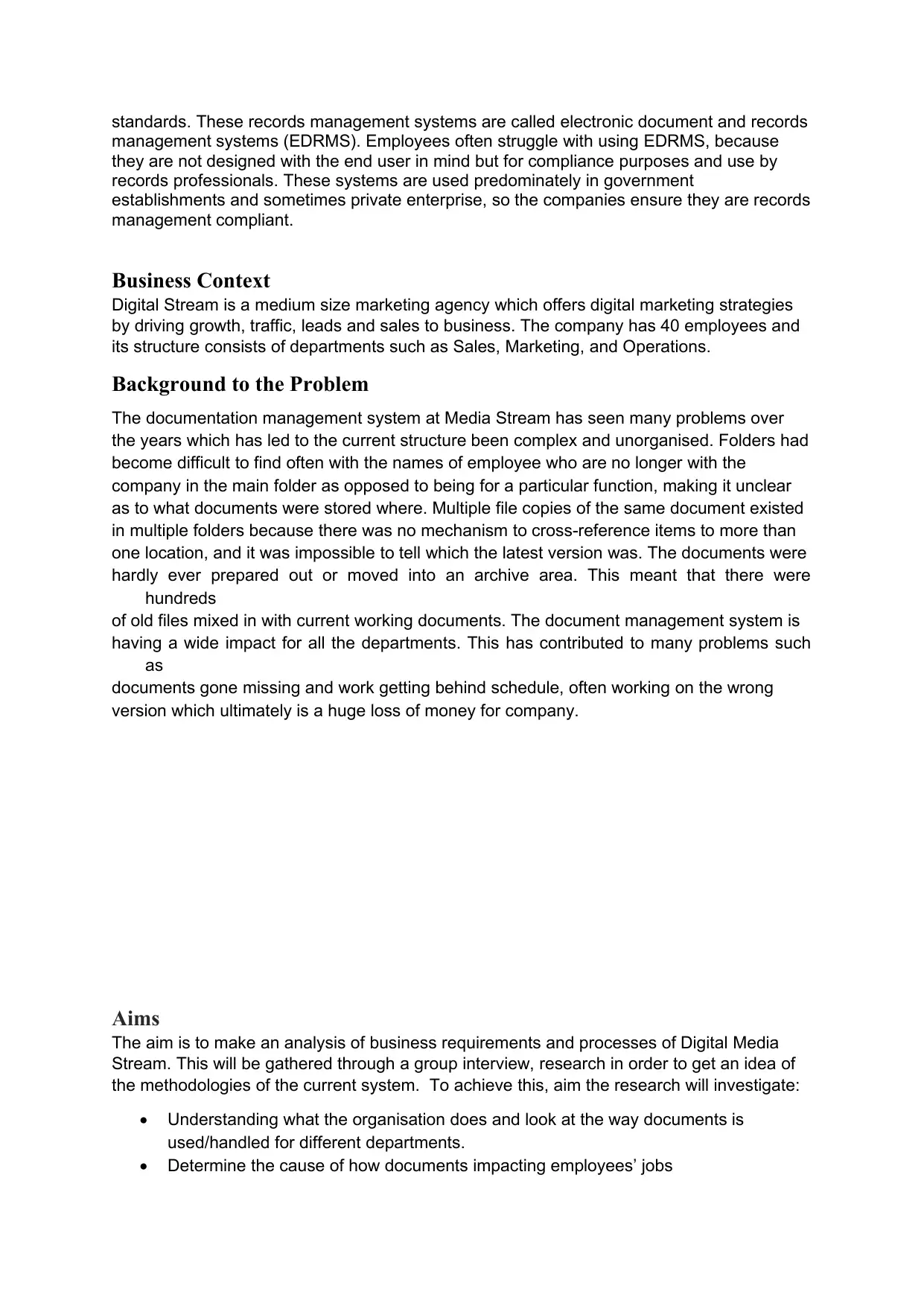
standards. These records management systems are called electronic document and records
management systems (EDRMS). Employees often struggle with using EDRMS, because
they are not designed with the end user in mind but for compliance purposes and use by
records professionals. These systems are used predominately in government
establishments and sometimes private enterprise, so the companies ensure they are records
management compliant.
Business Context
Digital Stream is a medium size marketing agency which offers digital marketing strategies
by driving growth, traffic, leads and sales to business. The company has 40 employees and
its structure consists of departments such as Sales, Marketing, and Operations.
Background to the Problem
The documentation management system at Media Stream has seen many problems over
the years which has led to the current structure been complex and unorganised. Folders had
become difficult to find often with the names of employee who are no longer with the
company in the main folder as opposed to being for a particular function, making it unclear
as to what documents were stored where. Multiple file copies of the same document existed
in multiple folders because there was no mechanism to cross-reference items to more than
one location, and it was impossible to tell which the latest version was. The documents were
hardly ever prepared out or moved into an archive area. This meant that there were
hundreds
of old files mixed in with current working documents. The document management system is
having a wide impact for all the departments. This has contributed to many problems such
as
documents gone missing and work getting behind schedule, often working on the wrong
version which ultimately is a huge loss of money for company.
Aims
The aim is to make an analysis of business requirements and processes of Digital Media
Stream. This will be gathered through a group interview, research in order to get an idea of
the methodologies of the current system. To achieve this, aim the research will investigate:
Understanding what the organisation does and look at the way documents is
used/handled for different departments.
Determine the cause of how documents impacting employees’ jobs
management systems (EDRMS). Employees often struggle with using EDRMS, because
they are not designed with the end user in mind but for compliance purposes and use by
records professionals. These systems are used predominately in government
establishments and sometimes private enterprise, so the companies ensure they are records
management compliant.
Business Context
Digital Stream is a medium size marketing agency which offers digital marketing strategies
by driving growth, traffic, leads and sales to business. The company has 40 employees and
its structure consists of departments such as Sales, Marketing, and Operations.
Background to the Problem
The documentation management system at Media Stream has seen many problems over
the years which has led to the current structure been complex and unorganised. Folders had
become difficult to find often with the names of employee who are no longer with the
company in the main folder as opposed to being for a particular function, making it unclear
as to what documents were stored where. Multiple file copies of the same document existed
in multiple folders because there was no mechanism to cross-reference items to more than
one location, and it was impossible to tell which the latest version was. The documents were
hardly ever prepared out or moved into an archive area. This meant that there were
hundreds
of old files mixed in with current working documents. The document management system is
having a wide impact for all the departments. This has contributed to many problems such
as
documents gone missing and work getting behind schedule, often working on the wrong
version which ultimately is a huge loss of money for company.
Aims
The aim is to make an analysis of business requirements and processes of Digital Media
Stream. This will be gathered through a group interview, research in order to get an idea of
the methodologies of the current system. To achieve this, aim the research will investigate:
Understanding what the organisation does and look at the way documents is
used/handled for different departments.
Determine the cause of how documents impacting employees’ jobs
Paraphrase This Document
Need a fresh take? Get an instant paraphrase of this document with our AI Paraphraser
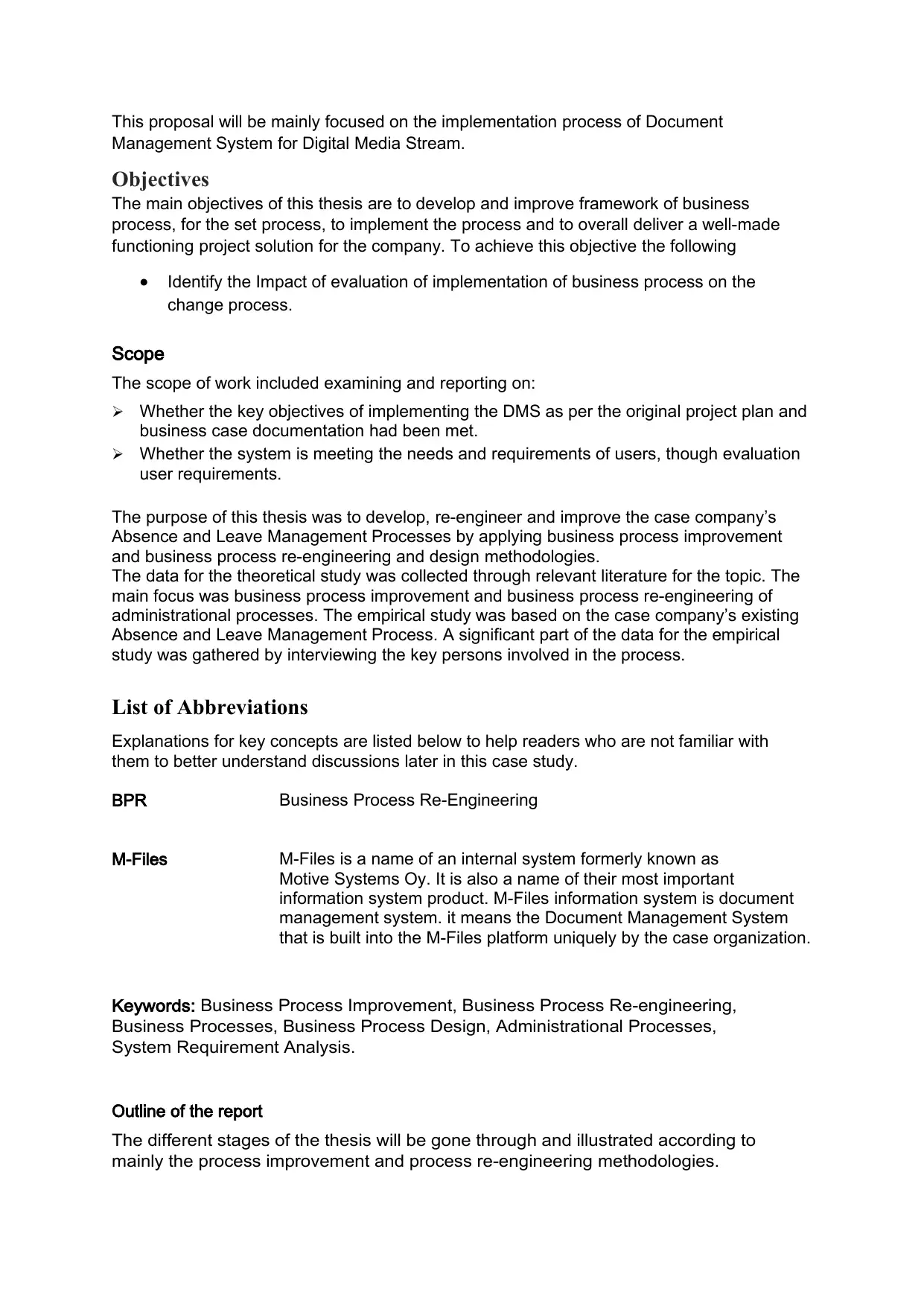
This proposal will be mainly focused on the implementation process of Document
Management System for Digital Media Stream.
Objectives
The main objectives of this thesis are to develop and improve framework of business
process, for the set process, to implement the process and to overall deliver a well-made
functioning project solution for the company. To achieve this objective the following
Identify the Impact of evaluation of implementation of business process on the
change process.
Scope
The scope of work included examining and reporting on:
Whether the key objectives of implementing the DMS as per the original project plan and
business case documentation had been met.
Whether the system is meeting the needs and requirements of users, though evaluation
user requirements.
The purpose of this thesis was to develop, re-engineer and improve the case company’s
Absence and Leave Management Processes by applying business process improvement
and business process re-engineering and design methodologies.
The data for the theoretical study was collected through relevant literature for the topic. The
main focus was business process improvement and business process re-engineering of
administrational processes. The empirical study was based on the case company’s existing
Absence and Leave Management Process. A significant part of the data for the empirical
study was gathered by interviewing the key persons involved in the process.
List of Abbreviations
Explanations for key concepts are listed below to help readers who are not familiar with
them to better understand discussions later in this case study.
BPR Business Process Re-Engineering
M-Files M-Files is a name of an internal system formerly known as
Motive Systems Oy. It is also a name of their most important
information system product. M-Files information system is document
management system. it means the Document Management System
that is built into the M-Files platform uniquely by the case organization.
Keywords: Business Process Improvement, Business Process Re-engineering,
Business Processes, Business Process Design, Administrational Processes,
System Requirement Analysis.
Outline of the report
The different stages of the thesis will be gone through and illustrated according to
mainly the process improvement and process re-engineering methodologies.
Management System for Digital Media Stream.
Objectives
The main objectives of this thesis are to develop and improve framework of business
process, for the set process, to implement the process and to overall deliver a well-made
functioning project solution for the company. To achieve this objective the following
Identify the Impact of evaluation of implementation of business process on the
change process.
Scope
The scope of work included examining and reporting on:
Whether the key objectives of implementing the DMS as per the original project plan and
business case documentation had been met.
Whether the system is meeting the needs and requirements of users, though evaluation
user requirements.
The purpose of this thesis was to develop, re-engineer and improve the case company’s
Absence and Leave Management Processes by applying business process improvement
and business process re-engineering and design methodologies.
The data for the theoretical study was collected through relevant literature for the topic. The
main focus was business process improvement and business process re-engineering of
administrational processes. The empirical study was based on the case company’s existing
Absence and Leave Management Process. A significant part of the data for the empirical
study was gathered by interviewing the key persons involved in the process.
List of Abbreviations
Explanations for key concepts are listed below to help readers who are not familiar with
them to better understand discussions later in this case study.
BPR Business Process Re-Engineering
M-Files M-Files is a name of an internal system formerly known as
Motive Systems Oy. It is also a name of their most important
information system product. M-Files information system is document
management system. it means the Document Management System
that is built into the M-Files platform uniquely by the case organization.
Keywords: Business Process Improvement, Business Process Re-engineering,
Business Processes, Business Process Design, Administrational Processes,
System Requirement Analysis.
Outline of the report
The different stages of the thesis will be gone through and illustrated according to
mainly the process improvement and process re-engineering methodologies.
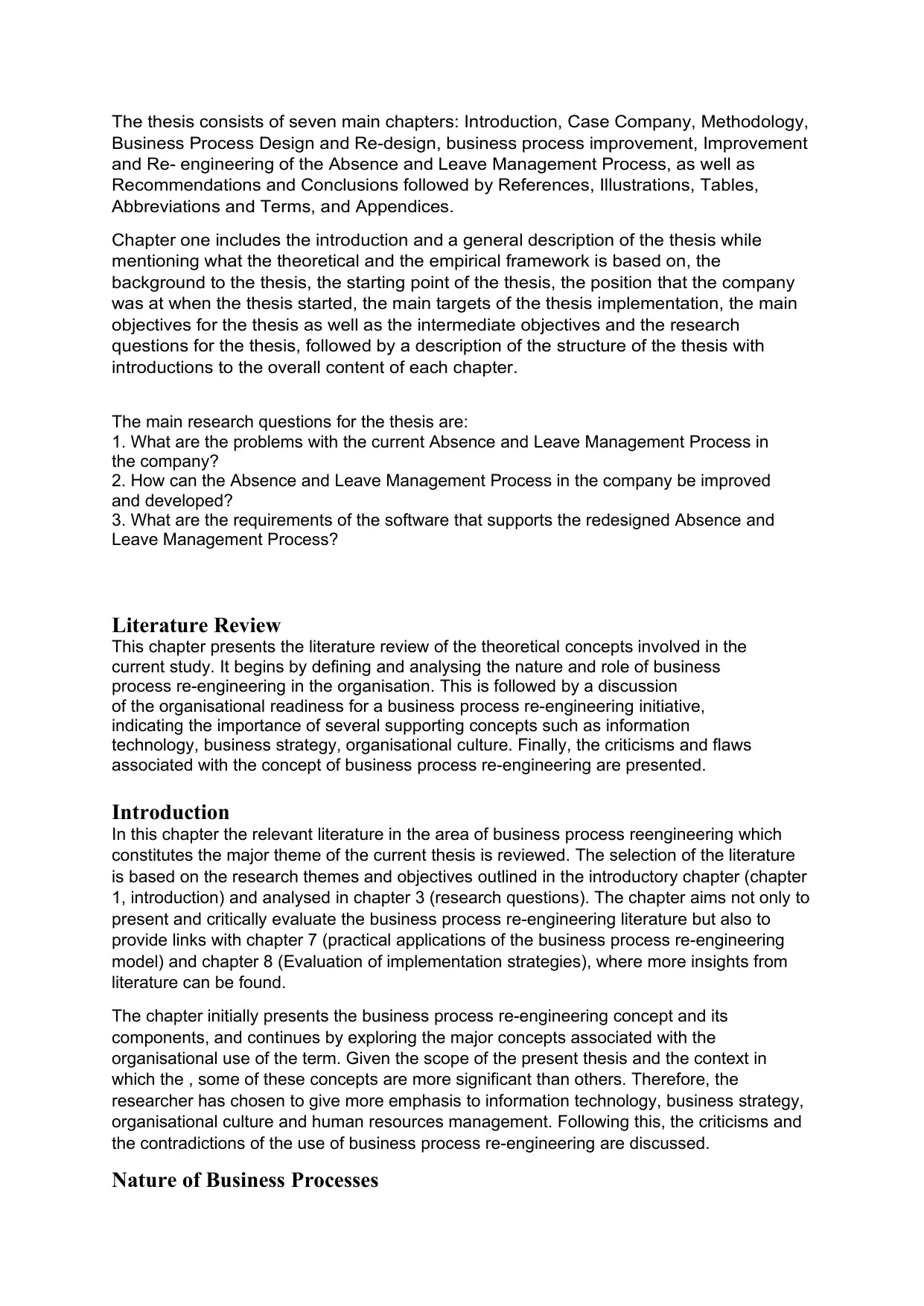
The thesis consists of seven main chapters: Introduction, Case Company, Methodology,
Business Process Design and Re-design, business process improvement, Improvement
and Re- engineering of the Absence and Leave Management Process, as well as
Recommendations and Conclusions followed by References, Illustrations, Tables,
Abbreviations and Terms, and Appendices.
Chapter one includes the introduction and a general description of the thesis while
mentioning what the theoretical and the empirical framework is based on, the
background to the thesis, the starting point of the thesis, the position that the company
was at when the thesis started, the main targets of the thesis implementation, the main
objectives for the thesis as well as the intermediate objectives and the research
questions for the thesis, followed by a description of the structure of the thesis with
introductions to the overall content of each chapter.
The main research questions for the thesis are:
1. What are the problems with the current Absence and Leave Management Process in
the company?
2. How can the Absence and Leave Management Process in the company be improved
and developed?
3. What are the requirements of the software that supports the redesigned Absence and
Leave Management Process?
Literature Review
This chapter presents the literature review of the theoretical concepts involved in the
current study. It begins by defining and analysing the nature and role of business
process re-engineering in the organisation. This is followed by a discussion
of the organisational readiness for a business process re-engineering initiative,
indicating the importance of several supporting concepts such as information
technology, business strategy, organisational culture. Finally, the criticisms and flaws
associated with the concept of business process re-engineering are presented.
Introduction
In this chapter the relevant literature in the area of business process reengineering which
constitutes the major theme of the current thesis is reviewed. The selection of the literature
is based on the research themes and objectives outlined in the introductory chapter (chapter
1, introduction) and analysed in chapter 3 (research questions). The chapter aims not only to
present and critically evaluate the business process re-engineering literature but also to
provide links with chapter 7 (practical applications of the business process re-engineering
model) and chapter 8 (Evaluation of implementation strategies), where more insights from
literature can be found.
The chapter initially presents the business process re-engineering concept and its
components, and continues by exploring the major concepts associated with the
organisational use of the term. Given the scope of the present thesis and the context in
which the , some of these concepts are more significant than others. Therefore, the
researcher has chosen to give more emphasis to information technology, business strategy,
organisational culture and human resources management. Following this, the criticisms and
the contradictions of the use of business process re-engineering are discussed.
Nature of Business Processes
Business Process Design and Re-design, business process improvement, Improvement
and Re- engineering of the Absence and Leave Management Process, as well as
Recommendations and Conclusions followed by References, Illustrations, Tables,
Abbreviations and Terms, and Appendices.
Chapter one includes the introduction and a general description of the thesis while
mentioning what the theoretical and the empirical framework is based on, the
background to the thesis, the starting point of the thesis, the position that the company
was at when the thesis started, the main targets of the thesis implementation, the main
objectives for the thesis as well as the intermediate objectives and the research
questions for the thesis, followed by a description of the structure of the thesis with
introductions to the overall content of each chapter.
The main research questions for the thesis are:
1. What are the problems with the current Absence and Leave Management Process in
the company?
2. How can the Absence and Leave Management Process in the company be improved
and developed?
3. What are the requirements of the software that supports the redesigned Absence and
Leave Management Process?
Literature Review
This chapter presents the literature review of the theoretical concepts involved in the
current study. It begins by defining and analysing the nature and role of business
process re-engineering in the organisation. This is followed by a discussion
of the organisational readiness for a business process re-engineering initiative,
indicating the importance of several supporting concepts such as information
technology, business strategy, organisational culture. Finally, the criticisms and flaws
associated with the concept of business process re-engineering are presented.
Introduction
In this chapter the relevant literature in the area of business process reengineering which
constitutes the major theme of the current thesis is reviewed. The selection of the literature
is based on the research themes and objectives outlined in the introductory chapter (chapter
1, introduction) and analysed in chapter 3 (research questions). The chapter aims not only to
present and critically evaluate the business process re-engineering literature but also to
provide links with chapter 7 (practical applications of the business process re-engineering
model) and chapter 8 (Evaluation of implementation strategies), where more insights from
literature can be found.
The chapter initially presents the business process re-engineering concept and its
components, and continues by exploring the major concepts associated with the
organisational use of the term. Given the scope of the present thesis and the context in
which the , some of these concepts are more significant than others. Therefore, the
researcher has chosen to give more emphasis to information technology, business strategy,
organisational culture and human resources management. Following this, the criticisms and
the contradictions of the use of business process re-engineering are discussed.
Nature of Business Processes
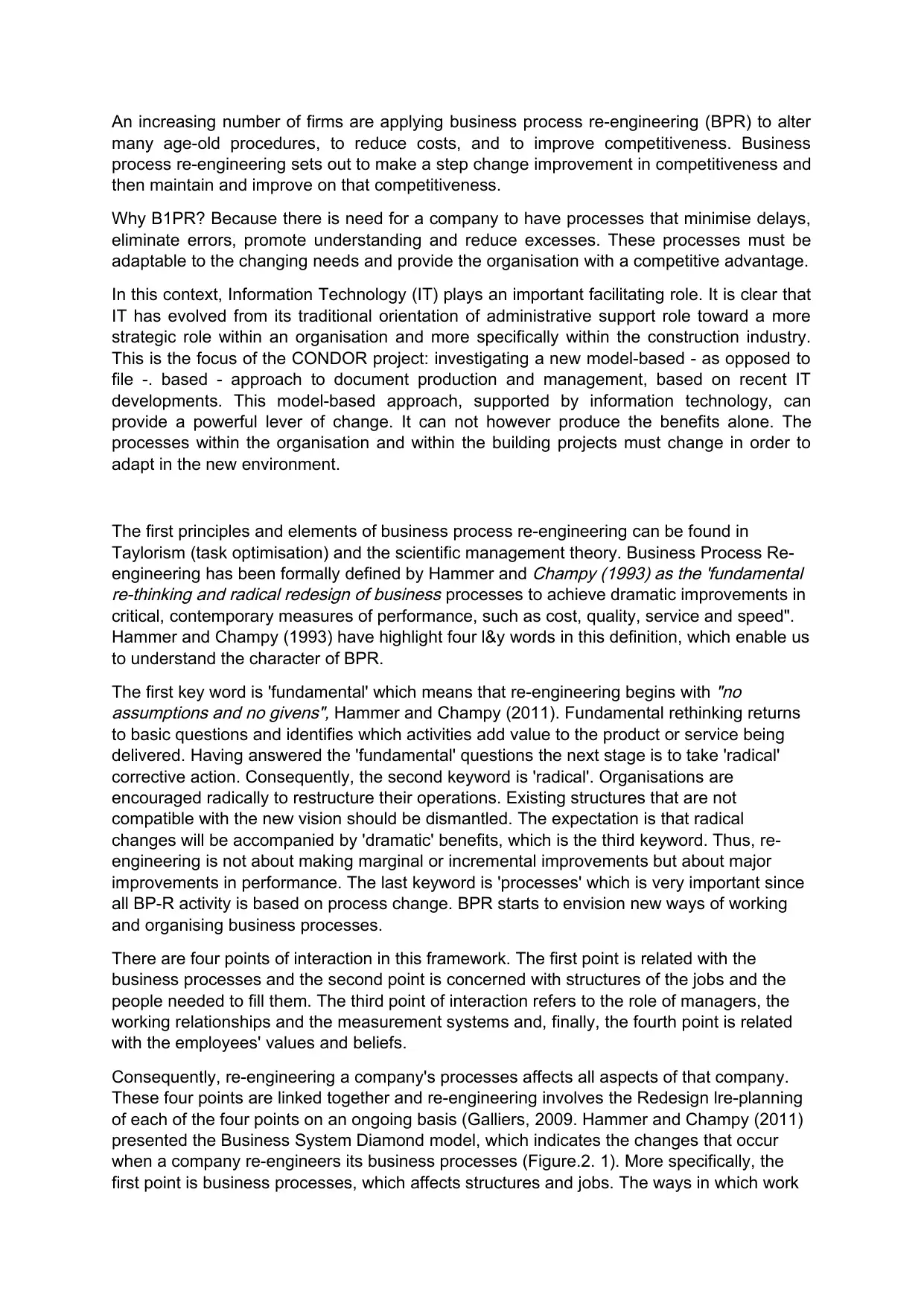
An increasing number of firms are applying business process re-engineering (BPR) to alter
many age-old procedures, to reduce costs, and to improve competitiveness. Business
process re-engineering sets out to make a step change improvement in competitiveness and
then maintain and improve on that competitiveness.
Why B1PR? Because there is need for a company to have processes that minimise delays,
eliminate errors, promote understanding and reduce excesses. These processes must be
adaptable to the changing needs and provide the organisation with a competitive advantage.
In this context, Information Technology (IT) plays an important facilitating role. It is clear that
IT has evolved from its traditional orientation of administrative support role toward a more
strategic role within an organisation and more specifically within the construction industry.
This is the focus of the CONDOR project: investigating a new model-based - as opposed to
file -. based - approach to document production and management, based on recent IT
developments. This model-based approach, supported by information technology, can
provide a powerful lever of change. It can not however produce the benefits alone. The
processes within the organisation and within the building projects must change in order to
adapt in the new environment.
The first principles and elements of business process re-engineering can be found in
Taylorism (task optimisation) and the scientific management theory. Business Process Re-
engineering has been formally defined by Hammer and
Champy (1993) as the 'fundamental
re-thinking and radical redesign of business processes to achieve dramatic improvements in
critical, contemporary measures of performance, such as cost, quality, service and speed".
Hammer and Champy (1993) have highlight four l&y words in this definition, which enable us
to understand the character of BPR.
The first key word is 'fundamental' which means that re-engineering begins with
"no
assumptions and no givens", Hammer and Champy (2011). Fundamental rethinking returns
to basic questions and identifies which activities add value to the product or service being
delivered. Having answered the 'fundamental' questions the next stage is to take 'radical'
corrective action. Consequently, the second keyword is 'radical'. Organisations are
encouraged radically to restructure their operations. Existing structures that are not
compatible with the new vision should be dismantled. The expectation is that radical
changes will be accompanied by 'dramatic' benefits, which is the third keyword. Thus, re-
engineering is not about making marginal or incremental improvements but about major
improvements in performance. The last keyword is 'processes' which is very important since
all BP-R activity is based on process change. BPR starts to envision new ways of working
and organising business processes.
There are four points of interaction in this framework. The first point is related with the
business processes and the second point is concerned with structures of the jobs and the
people needed to fill them. The third point of interaction refers to the role of managers, the
working relationships and the measurement systems and, finally, the fourth point is related
with the employees' values and beliefs.
Consequently, re-engineering a company's processes affects all aspects of that company.
These four points are linked together and re-engineering involves the Redesign lre-planning
of each of the four points on an ongoing basis (Galliers, 2009. Hammer and Champy (2011)
presented the Business System Diamond model, which indicates the changes that occur
when a company re-engineers its business processes (Figure.2. 1). More specifically, the
first point is business processes, which affects structures and jobs. The ways in which work
many age-old procedures, to reduce costs, and to improve competitiveness. Business
process re-engineering sets out to make a step change improvement in competitiveness and
then maintain and improve on that competitiveness.
Why B1PR? Because there is need for a company to have processes that minimise delays,
eliminate errors, promote understanding and reduce excesses. These processes must be
adaptable to the changing needs and provide the organisation with a competitive advantage.
In this context, Information Technology (IT) plays an important facilitating role. It is clear that
IT has evolved from its traditional orientation of administrative support role toward a more
strategic role within an organisation and more specifically within the construction industry.
This is the focus of the CONDOR project: investigating a new model-based - as opposed to
file -. based - approach to document production and management, based on recent IT
developments. This model-based approach, supported by information technology, can
provide a powerful lever of change. It can not however produce the benefits alone. The
processes within the organisation and within the building projects must change in order to
adapt in the new environment.
The first principles and elements of business process re-engineering can be found in
Taylorism (task optimisation) and the scientific management theory. Business Process Re-
engineering has been formally defined by Hammer and
Champy (1993) as the 'fundamental
re-thinking and radical redesign of business processes to achieve dramatic improvements in
critical, contemporary measures of performance, such as cost, quality, service and speed".
Hammer and Champy (1993) have highlight four l&y words in this definition, which enable us
to understand the character of BPR.
The first key word is 'fundamental' which means that re-engineering begins with
"no
assumptions and no givens", Hammer and Champy (2011). Fundamental rethinking returns
to basic questions and identifies which activities add value to the product or service being
delivered. Having answered the 'fundamental' questions the next stage is to take 'radical'
corrective action. Consequently, the second keyword is 'radical'. Organisations are
encouraged radically to restructure their operations. Existing structures that are not
compatible with the new vision should be dismantled. The expectation is that radical
changes will be accompanied by 'dramatic' benefits, which is the third keyword. Thus, re-
engineering is not about making marginal or incremental improvements but about major
improvements in performance. The last keyword is 'processes' which is very important since
all BP-R activity is based on process change. BPR starts to envision new ways of working
and organising business processes.
There are four points of interaction in this framework. The first point is related with the
business processes and the second point is concerned with structures of the jobs and the
people needed to fill them. The third point of interaction refers to the role of managers, the
working relationships and the measurement systems and, finally, the fourth point is related
with the employees' values and beliefs.
Consequently, re-engineering a company's processes affects all aspects of that company.
These four points are linked together and re-engineering involves the Redesign lre-planning
of each of the four points on an ongoing basis (Galliers, 2009. Hammer and Champy (2011)
presented the Business System Diamond model, which indicates the changes that occur
when a company re-engineers its business processes (Figure.2. 1). More specifically, the
first point is business processes, which affects structures and jobs. The ways in which work
Secure Best Marks with AI Grader
Need help grading? Try our AI Grader for instant feedback on your assignments.
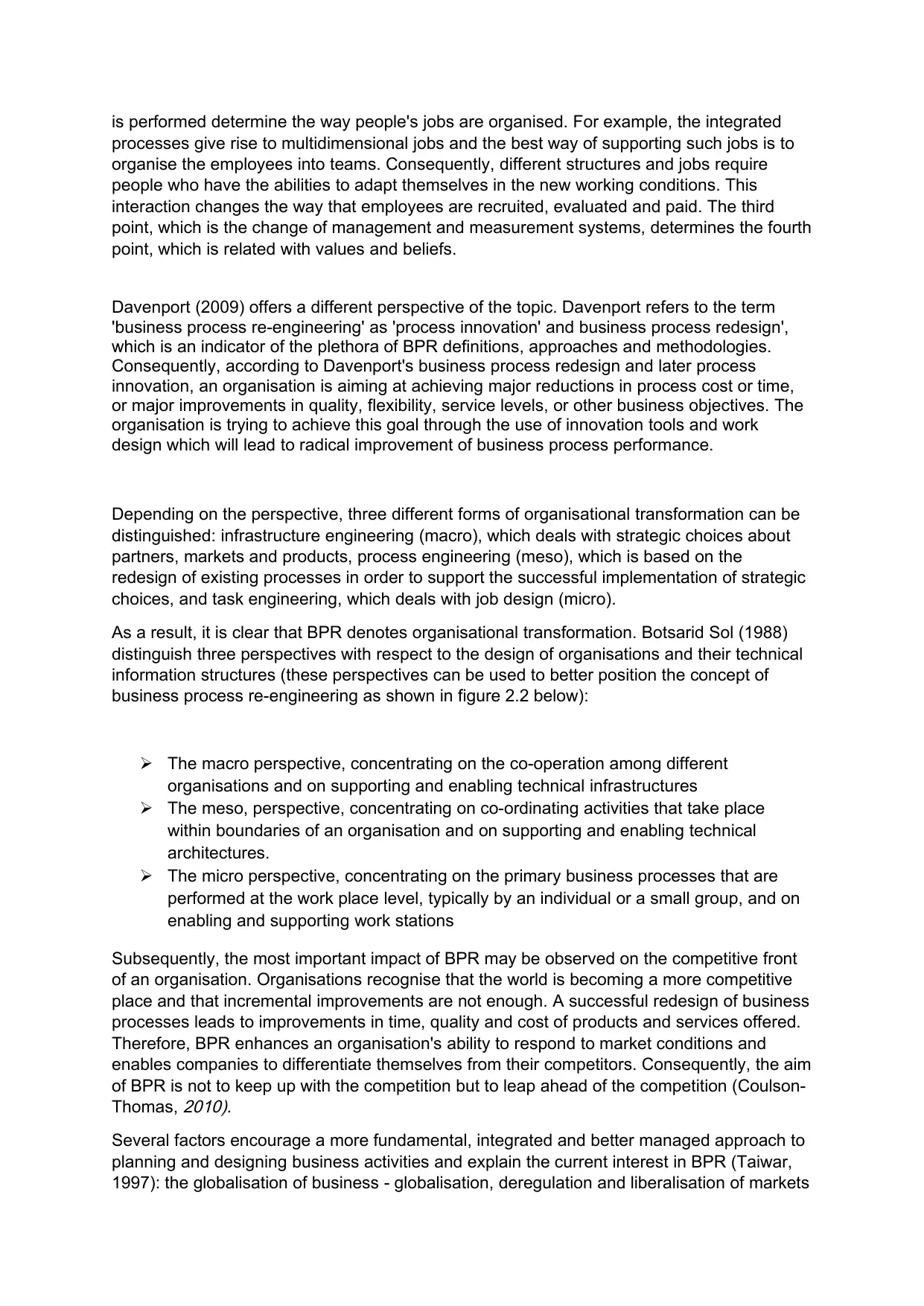
is performed determine the way people's jobs are organised. For example, the integrated
processes give rise to multidimensional jobs and the best way of supporting such jobs is to
organise the employees into teams. Consequently, different structures and jobs require
people who have the abilities to adapt themselves in the new working conditions. This
interaction changes the way that employees are recruited, evaluated and paid. The third
point, which is the change of management and measurement systems, determines the fourth
point, which is related with values and beliefs.
Davenport (2009) offers a different perspective of the topic. Davenport refers to the term
'business process re-engineering' as 'process innovation' and business process redesign',
which is an indicator of the plethora of BPR definitions, approaches and methodologies.
Consequently, according to Davenport's business process redesign and later process
innovation, an organisation is aiming at achieving major reductions in process cost or time,
or major improvements in quality, flexibility, service levels, or other business objectives. The
organisation is trying to achieve this goal through the use of innovation tools and work
design which will lead to radical improvement of business process performance.
Depending on the perspective, three different forms of organisational transformation can be
distinguished: infrastructure engineering (macro), which deals with strategic choices about
partners, markets and products, process engineering (meso), which is based on the
redesign of existing processes in order to support the successful implementation of strategic
choices, and task engineering, which deals with job design (micro).
As a result, it is clear that BPR denotes organisational transformation. Botsarid Sol (1988)
distinguish three perspectives with respect to the design of organisations and their technical
information structures (these perspectives can be used to better position the concept of
business process re-engineering as shown in figure 2.2 below):
The macro perspective, concentrating on the co-operation among different
organisations and on supporting and enabling technical infrastructures
The meso, perspective, concentrating on co-ordinating activities that take place
within boundaries of an organisation and on supporting and enabling technical
architectures.
The micro perspective, concentrating on the primary business processes that are
performed at the work place level, typically by an individual or a small group, and on
enabling and supporting work stations
Subsequently, the most important impact of BPR may be observed on the competitive front
of an organisation. Organisations recognise that the world is becoming a more competitive
place and that incremental improvements are not enough. A successful redesign of business
processes leads to improvements in time, quality and cost of products and services offered.
Therefore, BPR enhances an organisation's ability to respond to market conditions and
enables companies to differentiate themselves from their competitors. Consequently, the aim
of BPR is not to keep up with the competition but to leap ahead of the competition (Coulson-
Thomas,
2010).
Several factors encourage a more fundamental, integrated and better managed approach to
planning and designing business activities and explain the current interest in BPR (Taiwar,
1997): the globalisation of business - globalisation, deregulation and liberalisation of markets
processes give rise to multidimensional jobs and the best way of supporting such jobs is to
organise the employees into teams. Consequently, different structures and jobs require
people who have the abilities to adapt themselves in the new working conditions. This
interaction changes the way that employees are recruited, evaluated and paid. The third
point, which is the change of management and measurement systems, determines the fourth
point, which is related with values and beliefs.
Davenport (2009) offers a different perspective of the topic. Davenport refers to the term
'business process re-engineering' as 'process innovation' and business process redesign',
which is an indicator of the plethora of BPR definitions, approaches and methodologies.
Consequently, according to Davenport's business process redesign and later process
innovation, an organisation is aiming at achieving major reductions in process cost or time,
or major improvements in quality, flexibility, service levels, or other business objectives. The
organisation is trying to achieve this goal through the use of innovation tools and work
design which will lead to radical improvement of business process performance.
Depending on the perspective, three different forms of organisational transformation can be
distinguished: infrastructure engineering (macro), which deals with strategic choices about
partners, markets and products, process engineering (meso), which is based on the
redesign of existing processes in order to support the successful implementation of strategic
choices, and task engineering, which deals with job design (micro).
As a result, it is clear that BPR denotes organisational transformation. Botsarid Sol (1988)
distinguish three perspectives with respect to the design of organisations and their technical
information structures (these perspectives can be used to better position the concept of
business process re-engineering as shown in figure 2.2 below):
The macro perspective, concentrating on the co-operation among different
organisations and on supporting and enabling technical infrastructures
The meso, perspective, concentrating on co-ordinating activities that take place
within boundaries of an organisation and on supporting and enabling technical
architectures.
The micro perspective, concentrating on the primary business processes that are
performed at the work place level, typically by an individual or a small group, and on
enabling and supporting work stations
Subsequently, the most important impact of BPR may be observed on the competitive front
of an organisation. Organisations recognise that the world is becoming a more competitive
place and that incremental improvements are not enough. A successful redesign of business
processes leads to improvements in time, quality and cost of products and services offered.
Therefore, BPR enhances an organisation's ability to respond to market conditions and
enables companies to differentiate themselves from their competitors. Consequently, the aim
of BPR is not to keep up with the competition but to leap ahead of the competition (Coulson-
Thomas,
2010).
Several factors encourage a more fundamental, integrated and better managed approach to
planning and designing business activities and explain the current interest in BPR (Taiwar,
1997): the globalisation of business - globalisation, deregulation and liberalisation of markets
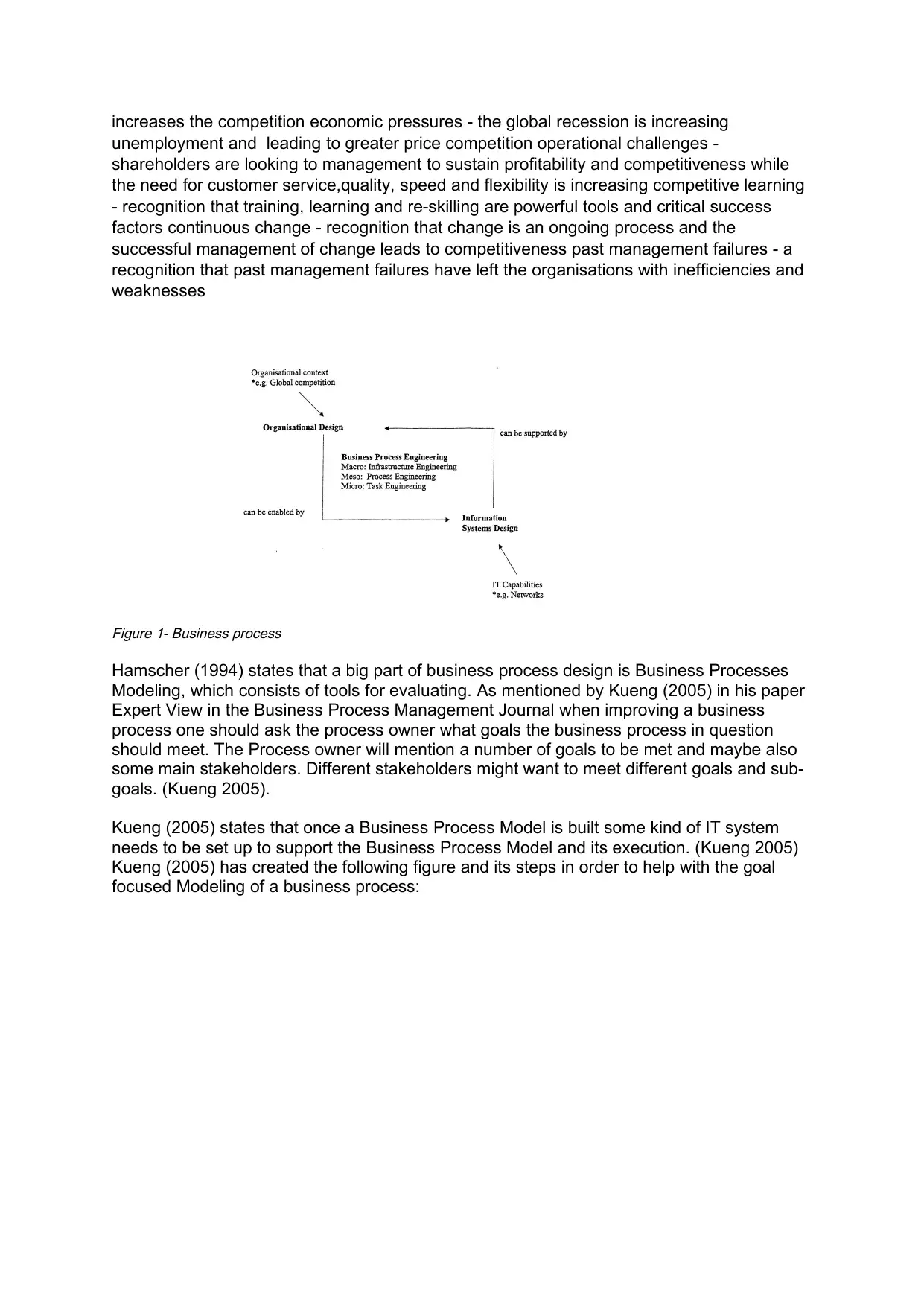
increases the competition economic pressures - the global recession is increasing
unemployment and leading to greater price competition operational challenges -
shareholders are looking to management to sustain profitability and competitiveness while
the need for customer service,quality, speed and flexibility is increasing competitive learning
- recognition that training, learning and re-skilling are powerful tools and critical success
factors continuous change - recognition that change is an ongoing process and the
successful management of change leads to competitiveness past management failures - a
recognition that past management failures have left the organisations with inefficiencies and
weaknesses
Figure 1- Business process
Hamscher (1994) states that a big part of business process design is Business Processes
Modeling, which consists of tools for evaluating. As mentioned by Kueng (2005) in his paper
Expert View in the Business Process Management Journal when improving a business
process one should ask the process owner what goals the business process in question
should meet. The Process owner will mention a number of goals to be met and maybe also
some main stakeholders. Different stakeholders might want to meet different goals and sub-
goals. (Kueng 2005).
Kueng (2005) states that once a Business Process Model is built some kind of IT system
needs to be set up to support the Business Process Model and its execution. (Kueng 2005)
Kueng (2005) has created the following figure and its steps in order to help with the goal
focused Modeling of a business process:
unemployment and leading to greater price competition operational challenges -
shareholders are looking to management to sustain profitability and competitiveness while
the need for customer service,quality, speed and flexibility is increasing competitive learning
- recognition that training, learning and re-skilling are powerful tools and critical success
factors continuous change - recognition that change is an ongoing process and the
successful management of change leads to competitiveness past management failures - a
recognition that past management failures have left the organisations with inefficiencies and
weaknesses
Figure 1- Business process
Hamscher (1994) states that a big part of business process design is Business Processes
Modeling, which consists of tools for evaluating. As mentioned by Kueng (2005) in his paper
Expert View in the Business Process Management Journal when improving a business
process one should ask the process owner what goals the business process in question
should meet. The Process owner will mention a number of goals to be met and maybe also
some main stakeholders. Different stakeholders might want to meet different goals and sub-
goals. (Kueng 2005).
Kueng (2005) states that once a Business Process Model is built some kind of IT system
needs to be set up to support the Business Process Model and its execution. (Kueng 2005)
Kueng (2005) has created the following figure and its steps in order to help with the goal
focused Modeling of a business process:
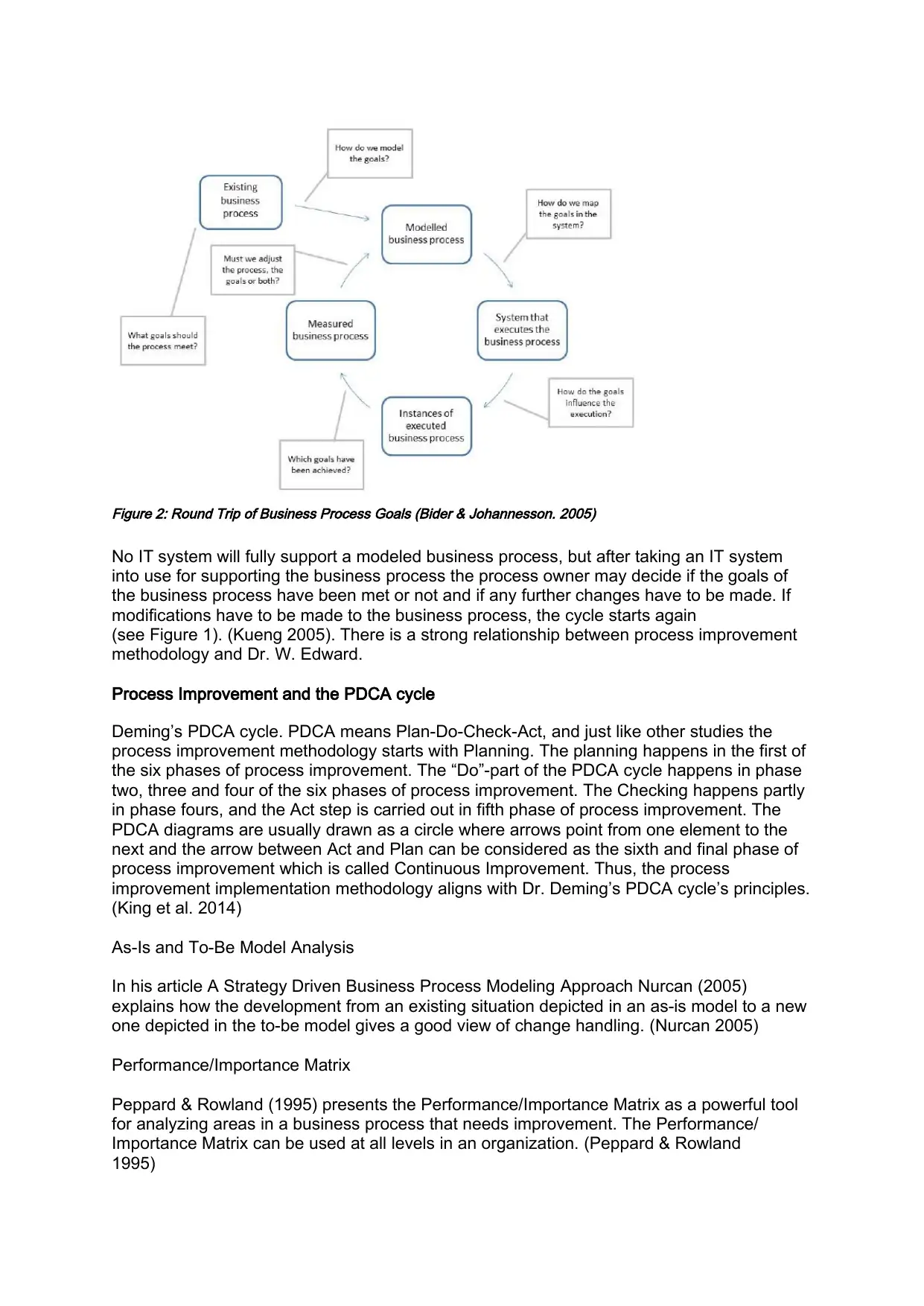
Figure 2: Round Trip of Business Process Goals (Bider & Johannesson. 2005)
No IT system will fully support a modeled business process, but after taking an IT system
into use for supporting the business process the process owner may decide if the goals of
the business process have been met or not and if any further changes have to be made. If
modifications have to be made to the business process, the cycle starts again
(see Figure 1). (Kueng 2005). There is a strong relationship between process improvement
methodology and Dr. W. Edward.
Process Improvement and the PDCA cycle
Deming’s PDCA cycle. PDCA means Plan-Do-Check-Act, and just like other studies the
process improvement methodology starts with Planning. The planning happens in the first of
the six phases of process improvement. The “Do”-part of the PDCA cycle happens in phase
two, three and four of the six phases of process improvement. The Checking happens partly
in phase fours, and the Act step is carried out in fifth phase of process improvement. The
PDCA diagrams are usually drawn as a circle where arrows point from one element to the
next and the arrow between Act and Plan can be considered as the sixth and final phase of
process improvement which is called Continuous Improvement. Thus, the process
improvement implementation methodology aligns with Dr. Deming’s PDCA cycle’s principles.
(King et al. 2014)
As-Is and To-Be Model Analysis
In his article A Strategy Driven Business Process Modeling Approach Nurcan (2005)
explains how the development from an existing situation depicted in an as-is model to a new
one depicted in the to-be model gives a good view of change handling. (Nurcan 2005)
Performance/Importance Matrix
Peppard & Rowland (1995) presents the Performance/Importance Matrix as a powerful tool
for analyzing areas in a business process that needs improvement. The Performance/
Importance Matrix can be used at all levels in an organization. (Peppard & Rowland
1995)
No IT system will fully support a modeled business process, but after taking an IT system
into use for supporting the business process the process owner may decide if the goals of
the business process have been met or not and if any further changes have to be made. If
modifications have to be made to the business process, the cycle starts again
(see Figure 1). (Kueng 2005). There is a strong relationship between process improvement
methodology and Dr. W. Edward.
Process Improvement and the PDCA cycle
Deming’s PDCA cycle. PDCA means Plan-Do-Check-Act, and just like other studies the
process improvement methodology starts with Planning. The planning happens in the first of
the six phases of process improvement. The “Do”-part of the PDCA cycle happens in phase
two, three and four of the six phases of process improvement. The Checking happens partly
in phase fours, and the Act step is carried out in fifth phase of process improvement. The
PDCA diagrams are usually drawn as a circle where arrows point from one element to the
next and the arrow between Act and Plan can be considered as the sixth and final phase of
process improvement which is called Continuous Improvement. Thus, the process
improvement implementation methodology aligns with Dr. Deming’s PDCA cycle’s principles.
(King et al. 2014)
As-Is and To-Be Model Analysis
In his article A Strategy Driven Business Process Modeling Approach Nurcan (2005)
explains how the development from an existing situation depicted in an as-is model to a new
one depicted in the to-be model gives a good view of change handling. (Nurcan 2005)
Performance/Importance Matrix
Peppard & Rowland (1995) presents the Performance/Importance Matrix as a powerful tool
for analyzing areas in a business process that needs improvement. The Performance/
Importance Matrix can be used at all levels in an organization. (Peppard & Rowland
1995)
Paraphrase This Document
Need a fresh take? Get an instant paraphrase of this document with our AI Paraphraser
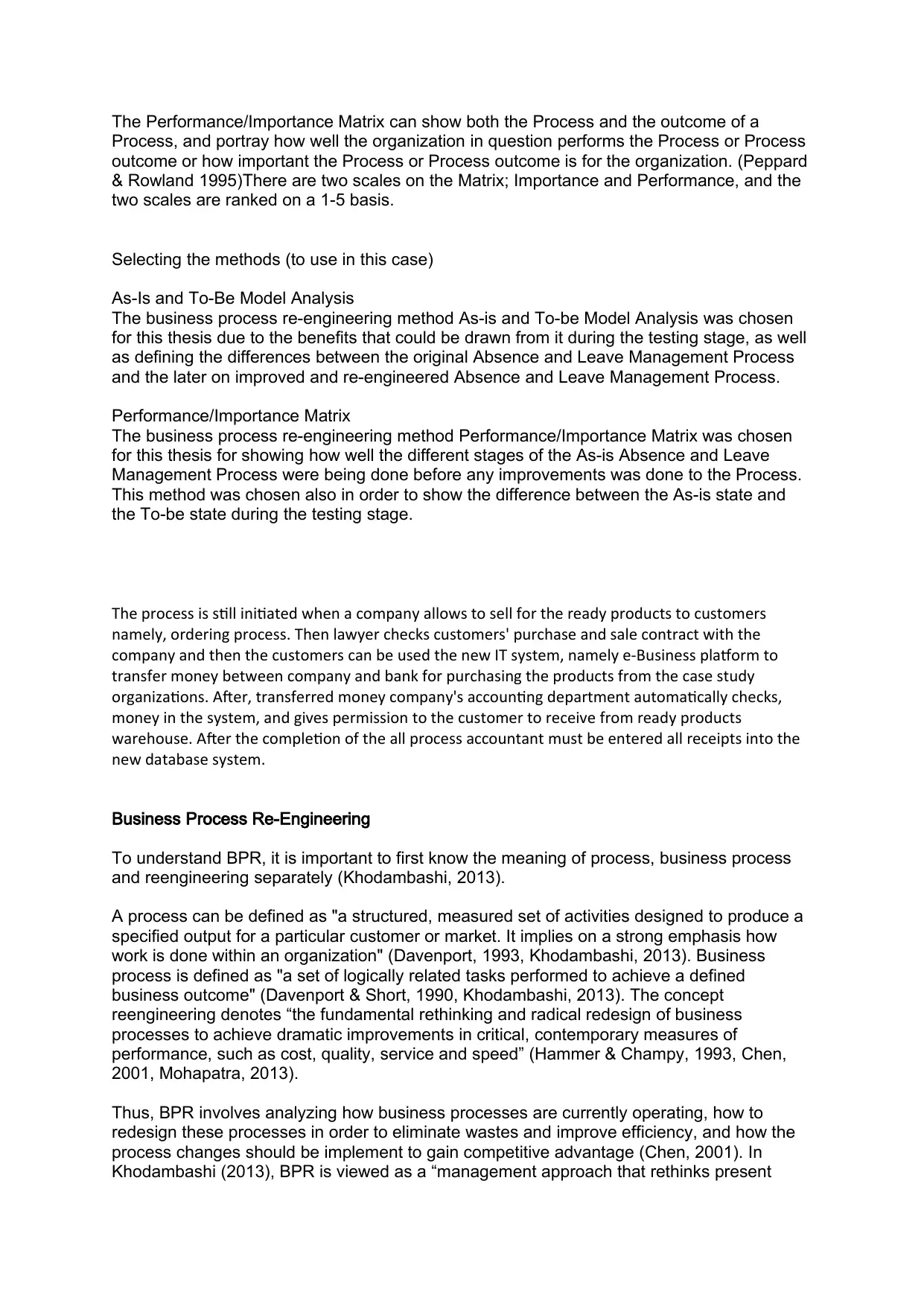
The Performance/Importance Matrix can show both the Process and the outcome of a
Process, and portray how well the organization in question performs the Process or Process
outcome or how important the Process or Process outcome is for the organization. (Peppard
& Rowland 1995)There are two scales on the Matrix; Importance and Performance, and the
two scales are ranked on a 1-5 basis.
Selecting the methods (to use in this case)
As-Is and To-Be Model Analysis
The business process re-engineering method As-is and To-be Model Analysis was chosen
for this thesis due to the benefits that could be drawn from it during the testing stage, as well
as defining the differences between the original Absence and Leave Management Process
and the later on improved and re-engineered Absence and Leave Management Process.
Performance/Importance Matrix
The business process re-engineering method Performance/Importance Matrix was chosen
for this thesis for showing how well the different stages of the As-is Absence and Leave
Management Process were being done before any improvements was done to the Process.
This method was chosen also in order to show the difference between the As-is state and
the To-be state during the testing stage.
The process is still initiated when a company allows to sell for the ready products to customers
namely, ordering process. Then lawyer checks customers' purchase and sale contract with the
company and then the customers can be used the new IT system, namely e-Business platform to
transfer money between company and bank for purchasing the products from the case study
organizations. After, transferred money company's accounting department automatically checks,
money in the system, and gives permission to the customer to receive from ready products
warehouse. After the completion of the all process accountant must be entered all receipts into the
new database system.
Business Process Re-Engineering
To understand BPR, it is important to first know the meaning of process, business process
and reengineering separately (Khodambashi, 2013).
A process can be defined as "a structured, measured set of activities designed to produce a
specified output for a particular customer or market. It implies on a strong emphasis how
work is done within an organization" (Davenport, 1993, Khodambashi, 2013). Business
process is defined as "a set of logically related tasks performed to achieve a defined
business outcome" (Davenport & Short, 1990, Khodambashi, 2013). The concept
reengineering denotes “the fundamental rethinking and radical redesign of business
processes to achieve dramatic improvements in critical, contemporary measures of
performance, such as cost, quality, service and speed” (Hammer & Champy, 1993, Chen,
2001, Mohapatra, 2013).
Thus, BPR involves analyzing how business processes are currently operating, how to
redesign these processes in order to eliminate wastes and improve efficiency, and how the
process changes should be implement to gain competitive advantage (Chen, 2001). In
Khodambashi (2013), BPR is viewed as a “management approach that rethinks present
Process, and portray how well the organization in question performs the Process or Process
outcome or how important the Process or Process outcome is for the organization. (Peppard
& Rowland 1995)There are two scales on the Matrix; Importance and Performance, and the
two scales are ranked on a 1-5 basis.
Selecting the methods (to use in this case)
As-Is and To-Be Model Analysis
The business process re-engineering method As-is and To-be Model Analysis was chosen
for this thesis due to the benefits that could be drawn from it during the testing stage, as well
as defining the differences between the original Absence and Leave Management Process
and the later on improved and re-engineered Absence and Leave Management Process.
Performance/Importance Matrix
The business process re-engineering method Performance/Importance Matrix was chosen
for this thesis for showing how well the different stages of the As-is Absence and Leave
Management Process were being done before any improvements was done to the Process.
This method was chosen also in order to show the difference between the As-is state and
the To-be state during the testing stage.
The process is still initiated when a company allows to sell for the ready products to customers
namely, ordering process. Then lawyer checks customers' purchase and sale contract with the
company and then the customers can be used the new IT system, namely e-Business platform to
transfer money between company and bank for purchasing the products from the case study
organizations. After, transferred money company's accounting department automatically checks,
money in the system, and gives permission to the customer to receive from ready products
warehouse. After the completion of the all process accountant must be entered all receipts into the
new database system.
Business Process Re-Engineering
To understand BPR, it is important to first know the meaning of process, business process
and reengineering separately (Khodambashi, 2013).
A process can be defined as "a structured, measured set of activities designed to produce a
specified output for a particular customer or market. It implies on a strong emphasis how
work is done within an organization" (Davenport, 1993, Khodambashi, 2013). Business
process is defined as "a set of logically related tasks performed to achieve a defined
business outcome" (Davenport & Short, 1990, Khodambashi, 2013). The concept
reengineering denotes “the fundamental rethinking and radical redesign of business
processes to achieve dramatic improvements in critical, contemporary measures of
performance, such as cost, quality, service and speed” (Hammer & Champy, 1993, Chen,
2001, Mohapatra, 2013).
Thus, BPR involves analyzing how business processes are currently operating, how to
redesign these processes in order to eliminate wastes and improve efficiency, and how the
process changes should be implement to gain competitive advantage (Chen, 2001). In
Khodambashi (2013), BPR is viewed as a “management approach that rethinks present
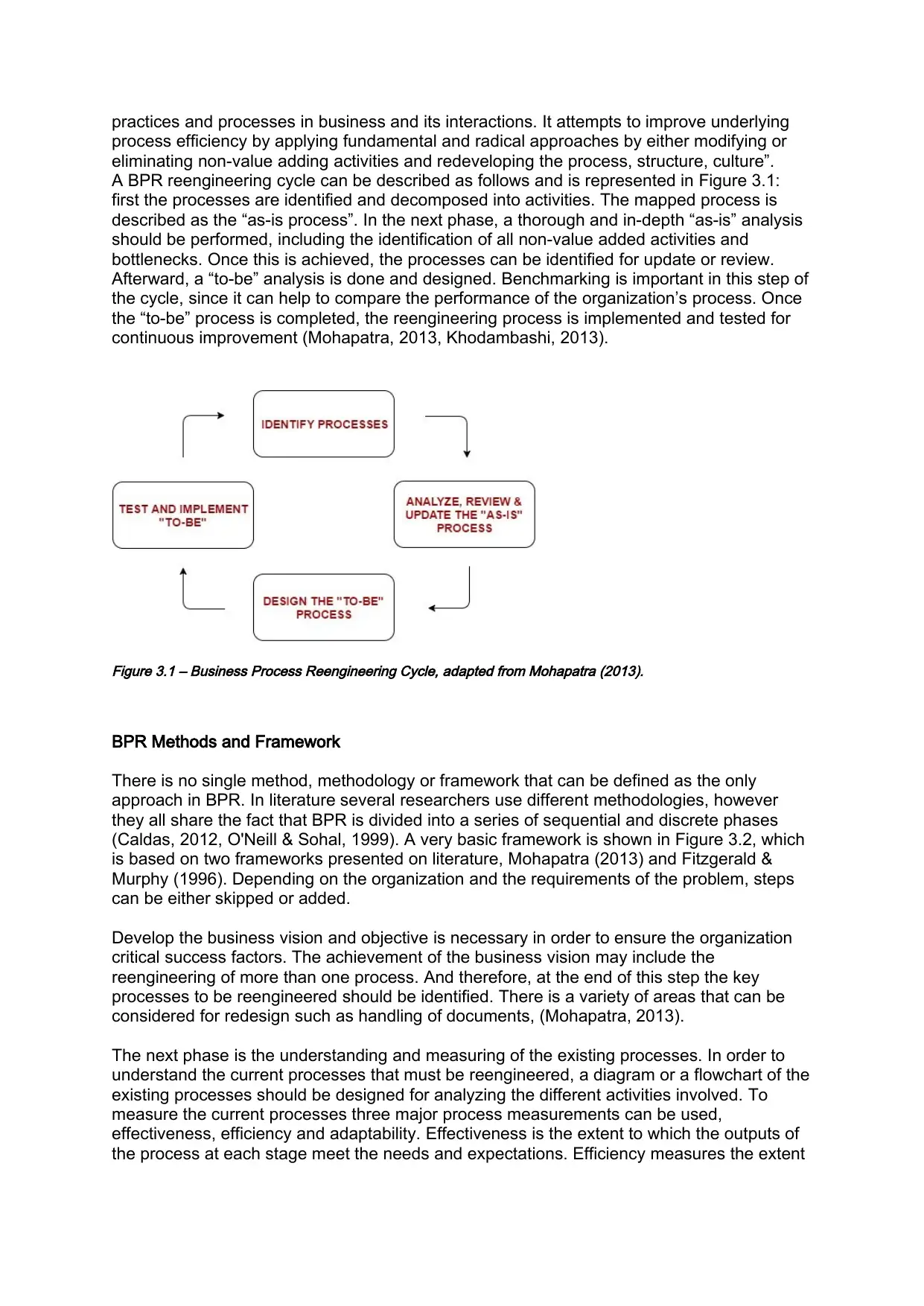
practices and processes in business and its interactions. It attempts to improve underlying
process efficiency by applying fundamental and radical approaches by either modifying or
eliminating non-value adding activities and redeveloping the process, structure, culture”.
A BPR reengineering cycle can be described as follows and is represented in Figure 3.1:
first the processes are identified and decomposed into activities. The mapped process is
described as the “as-is process”. In the next phase, a thorough and in-depth “as-is” analysis
should be performed, including the identification of all non-value added activities and
bottlenecks. Once this is achieved, the processes can be identified for update or review.
Afterward, a “to-be” analysis is done and designed. Benchmarking is important in this step of
the cycle, since it can help to compare the performance of the organization’s process. Once
the “to-be” process is completed, the reengineering process is implemented and tested for
continuous improvement (Mohapatra, 2013, Khodambashi, 2013).
Figure 3.1 – Business Process Reengineering Cycle, adapted from Mohapatra (2013).
BPR Methods and Framework
There is no single method, methodology or framework that can be defined as the only
approach in BPR. In literature several researchers use different methodologies, however
they all share the fact that BPR is divided into a series of sequential and discrete phases
(Caldas, 2012, O'Neill & Sohal, 1999). A very basic framework is shown in Figure 3.2, which
is based on two frameworks presented on literature, Mohapatra (2013) and Fitzgerald &
Murphy (1996). Depending on the organization and the requirements of the problem, steps
can be either skipped or added.
Develop the business vision and objective is necessary in order to ensure the organization
critical success factors. The achievement of the business vision may include the
reengineering of more than one process. And therefore, at the end of this step the key
processes to be reengineered should be identified. There is a variety of areas that can be
considered for redesign such as handling of documents, (Mohapatra, 2013).
The next phase is the understanding and measuring of the existing processes. In order to
understand the current processes that must be reengineered, a diagram or a flowchart of the
existing processes should be designed for analyzing the different activities involved. To
measure the current processes three major process measurements can be used,
effectiveness, efficiency and adaptability. Effectiveness is the extent to which the outputs of
the process at each stage meet the needs and expectations. Efficiency measures the extent
process efficiency by applying fundamental and radical approaches by either modifying or
eliminating non-value adding activities and redeveloping the process, structure, culture”.
A BPR reengineering cycle can be described as follows and is represented in Figure 3.1:
first the processes are identified and decomposed into activities. The mapped process is
described as the “as-is process”. In the next phase, a thorough and in-depth “as-is” analysis
should be performed, including the identification of all non-value added activities and
bottlenecks. Once this is achieved, the processes can be identified for update or review.
Afterward, a “to-be” analysis is done and designed. Benchmarking is important in this step of
the cycle, since it can help to compare the performance of the organization’s process. Once
the “to-be” process is completed, the reengineering process is implemented and tested for
continuous improvement (Mohapatra, 2013, Khodambashi, 2013).
Figure 3.1 – Business Process Reengineering Cycle, adapted from Mohapatra (2013).
BPR Methods and Framework
There is no single method, methodology or framework that can be defined as the only
approach in BPR. In literature several researchers use different methodologies, however
they all share the fact that BPR is divided into a series of sequential and discrete phases
(Caldas, 2012, O'Neill & Sohal, 1999). A very basic framework is shown in Figure 3.2, which
is based on two frameworks presented on literature, Mohapatra (2013) and Fitzgerald &
Murphy (1996). Depending on the organization and the requirements of the problem, steps
can be either skipped or added.
Develop the business vision and objective is necessary in order to ensure the organization
critical success factors. The achievement of the business vision may include the
reengineering of more than one process. And therefore, at the end of this step the key
processes to be reengineered should be identified. There is a variety of areas that can be
considered for redesign such as handling of documents, (Mohapatra, 2013).
The next phase is the understanding and measuring of the existing processes. In order to
understand the current processes that must be reengineered, a diagram or a flowchart of the
existing processes should be designed for analyzing the different activities involved. To
measure the current processes three major process measurements can be used,
effectiveness, efficiency and adaptability. Effectiveness is the extent to which the outputs of
the process at each stage meet the needs and expectations. Efficiency measures the extent
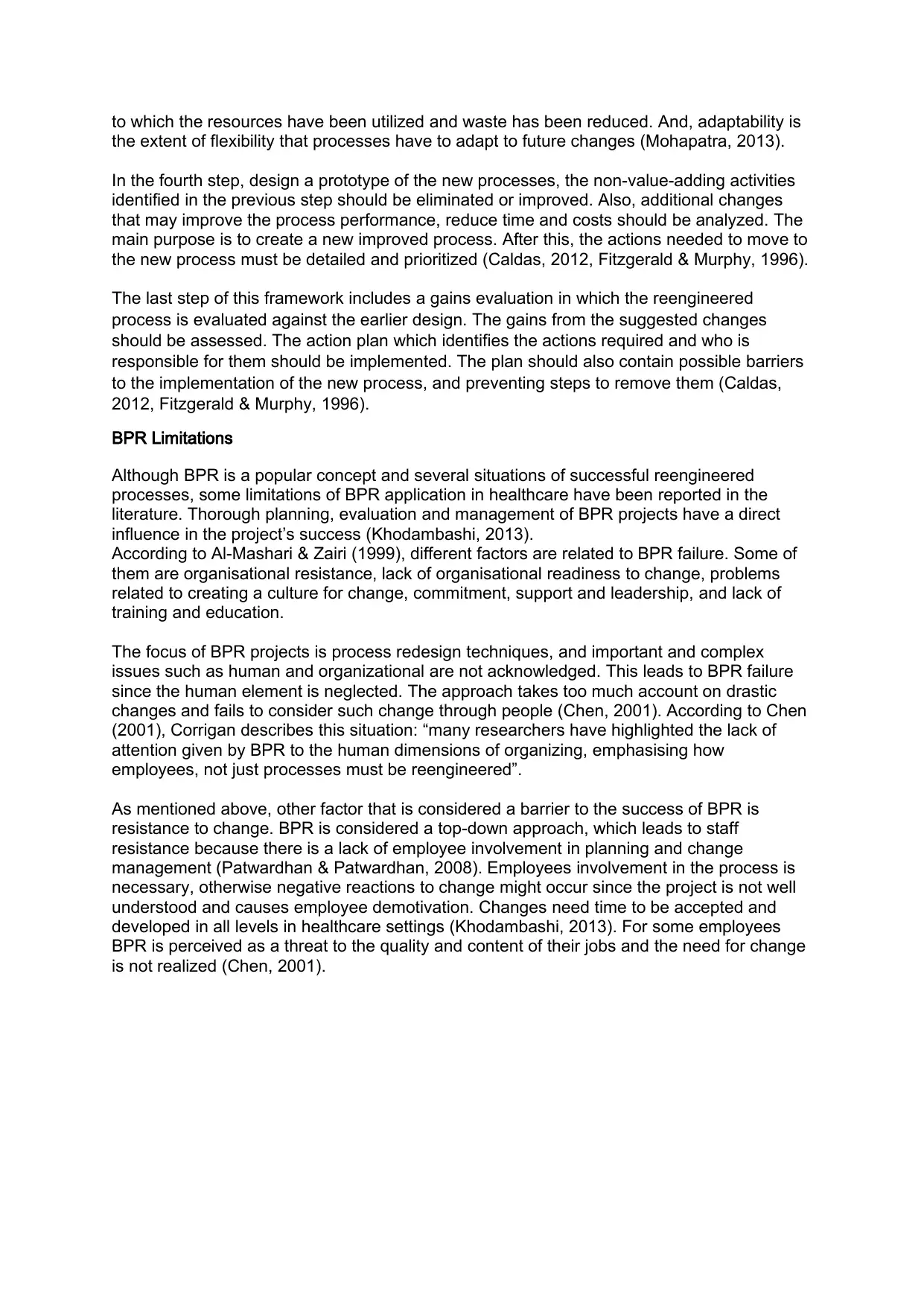
to which the resources have been utilized and waste has been reduced. And, adaptability is
the extent of flexibility that processes have to adapt to future changes (Mohapatra, 2013).
In the fourth step, design a prototype of the new processes, the non-value-adding activities
identified in the previous step should be eliminated or improved. Also, additional changes
that may improve the process performance, reduce time and costs should be analyzed. The
main purpose is to create a new improved process. After this, the actions needed to move to
the new process must be detailed and prioritized (Caldas, 2012, Fitzgerald & Murphy, 1996).
The last step of this framework includes a gains evaluation in which the reengineered
process is evaluated against the earlier design. The gains from the suggested changes
should be assessed. The action plan which identifies the actions required and who is
responsible for them should be implemented. The plan should also contain possible barriers
to the implementation of the new process, and preventing steps to remove them (Caldas,
2012, Fitzgerald & Murphy, 1996).
BPR Limitations
Although BPR is a popular concept and several situations of successful reengineered
processes, some limitations of BPR application in healthcare have been reported in the
literature. Thorough planning, evaluation and management of BPR projects have a direct
influence in the project’s success (Khodambashi, 2013).
According to Al-Mashari & Zairi (1999), different factors are related to BPR failure. Some of
them are organisational resistance, lack of organisational readiness to change, problems
related to creating a culture for change, commitment, support and leadership, and lack of
training and education.
The focus of BPR projects is process redesign techniques, and important and complex
issues such as human and organizational are not acknowledged. This leads to BPR failure
since the human element is neglected. The approach takes too much account on drastic
changes and fails to consider such change through people (Chen, 2001). According to Chen
(2001), Corrigan describes this situation: “many researchers have highlighted the lack of
attention given by BPR to the human dimensions of organizing, emphasising how
employees, not just processes must be reengineered”.
As mentioned above, other factor that is considered a barrier to the success of BPR is
resistance to change. BPR is considered a top-down approach, which leads to staff
resistance because there is a lack of employee involvement in planning and change
management (Patwardhan & Patwardhan, 2008). Employees involvement in the process is
necessary, otherwise negative reactions to change might occur since the project is not well
understood and causes employee demotivation. Changes need time to be accepted and
developed in all levels in healthcare settings (Khodambashi, 2013). For some employees
BPR is perceived as a threat to the quality and content of their jobs and the need for change
is not realized (Chen, 2001).
the extent of flexibility that processes have to adapt to future changes (Mohapatra, 2013).
In the fourth step, design a prototype of the new processes, the non-value-adding activities
identified in the previous step should be eliminated or improved. Also, additional changes
that may improve the process performance, reduce time and costs should be analyzed. The
main purpose is to create a new improved process. After this, the actions needed to move to
the new process must be detailed and prioritized (Caldas, 2012, Fitzgerald & Murphy, 1996).
The last step of this framework includes a gains evaluation in which the reengineered
process is evaluated against the earlier design. The gains from the suggested changes
should be assessed. The action plan which identifies the actions required and who is
responsible for them should be implemented. The plan should also contain possible barriers
to the implementation of the new process, and preventing steps to remove them (Caldas,
2012, Fitzgerald & Murphy, 1996).
BPR Limitations
Although BPR is a popular concept and several situations of successful reengineered
processes, some limitations of BPR application in healthcare have been reported in the
literature. Thorough planning, evaluation and management of BPR projects have a direct
influence in the project’s success (Khodambashi, 2013).
According to Al-Mashari & Zairi (1999), different factors are related to BPR failure. Some of
them are organisational resistance, lack of organisational readiness to change, problems
related to creating a culture for change, commitment, support and leadership, and lack of
training and education.
The focus of BPR projects is process redesign techniques, and important and complex
issues such as human and organizational are not acknowledged. This leads to BPR failure
since the human element is neglected. The approach takes too much account on drastic
changes and fails to consider such change through people (Chen, 2001). According to Chen
(2001), Corrigan describes this situation: “many researchers have highlighted the lack of
attention given by BPR to the human dimensions of organizing, emphasising how
employees, not just processes must be reengineered”.
As mentioned above, other factor that is considered a barrier to the success of BPR is
resistance to change. BPR is considered a top-down approach, which leads to staff
resistance because there is a lack of employee involvement in planning and change
management (Patwardhan & Patwardhan, 2008). Employees involvement in the process is
necessary, otherwise negative reactions to change might occur since the project is not well
understood and causes employee demotivation. Changes need time to be accepted and
developed in all levels in healthcare settings (Khodambashi, 2013). For some employees
BPR is perceived as a threat to the quality and content of their jobs and the need for change
is not realized (Chen, 2001).
Secure Best Marks with AI Grader
Need help grading? Try our AI Grader for instant feedback on your assignments.
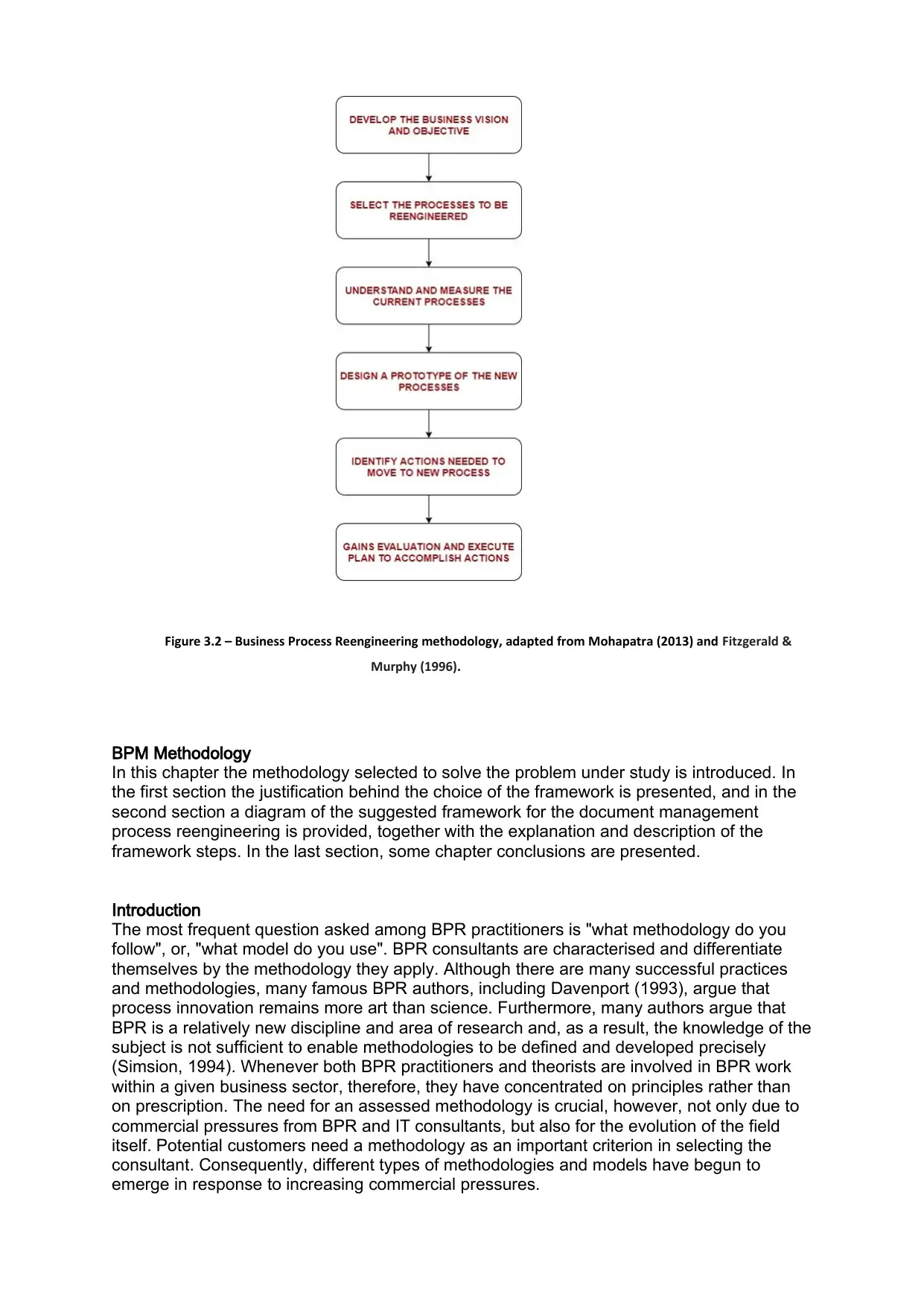
Figure 3.2 – Business Process Reengineering methodology, adapted from Mohapatra (2013) and Fitzgerald &
Murphy (1996).
BPM Methodology
In this chapter the methodology selected to solve the problem under study is introduced. In
the first section the justification behind the choice of the framework is presented, and in the
second section a diagram of the suggested framework for the document management
process reengineering is provided, together with the explanation and description of the
framework steps. In the last section, some chapter conclusions are presented.
Introduction
The most frequent question asked among BPR practitioners is "what methodology do you
follow", or, "what model do you use". BPR consultants are characterised and differentiate
themselves by the methodology they apply. Although there are many successful practices
and methodologies, many famous BPR authors, including Davenport (1993), argue that
process innovation remains more art than science. Furthermore, many authors argue that
BPR is a relatively new discipline and area of research and, as a result, the knowledge of the
subject is not sufficient to enable methodologies to be defined and developed precisely
(Simsion, 1994). Whenever both BPR practitioners and theorists are involved in BPR work
within a given business sector, therefore, they have concentrated on principles rather than
on prescription. The need for an assessed methodology is crucial, however, not only due to
commercial pressures from BPR and IT consultants, but also for the evolution of the field
itself. Potential customers need a methodology as an important criterion in selecting the
consultant. Consequently, different types of methodologies and models have begun to
emerge in response to increasing commercial pressures.
Murphy (1996).
BPM Methodology
In this chapter the methodology selected to solve the problem under study is introduced. In
the first section the justification behind the choice of the framework is presented, and in the
second section a diagram of the suggested framework for the document management
process reengineering is provided, together with the explanation and description of the
framework steps. In the last section, some chapter conclusions are presented.
Introduction
The most frequent question asked among BPR practitioners is "what methodology do you
follow", or, "what model do you use". BPR consultants are characterised and differentiate
themselves by the methodology they apply. Although there are many successful practices
and methodologies, many famous BPR authors, including Davenport (1993), argue that
process innovation remains more art than science. Furthermore, many authors argue that
BPR is a relatively new discipline and area of research and, as a result, the knowledge of the
subject is not sufficient to enable methodologies to be defined and developed precisely
(Simsion, 1994). Whenever both BPR practitioners and theorists are involved in BPR work
within a given business sector, therefore, they have concentrated on principles rather than
on prescription. The need for an assessed methodology is crucial, however, not only due to
commercial pressures from BPR and IT consultants, but also for the evolution of the field
itself. Potential customers need a methodology as an important criterion in selecting the
consultant. Consequently, different types of methodologies and models have begun to
emerge in response to increasing commercial pressures.
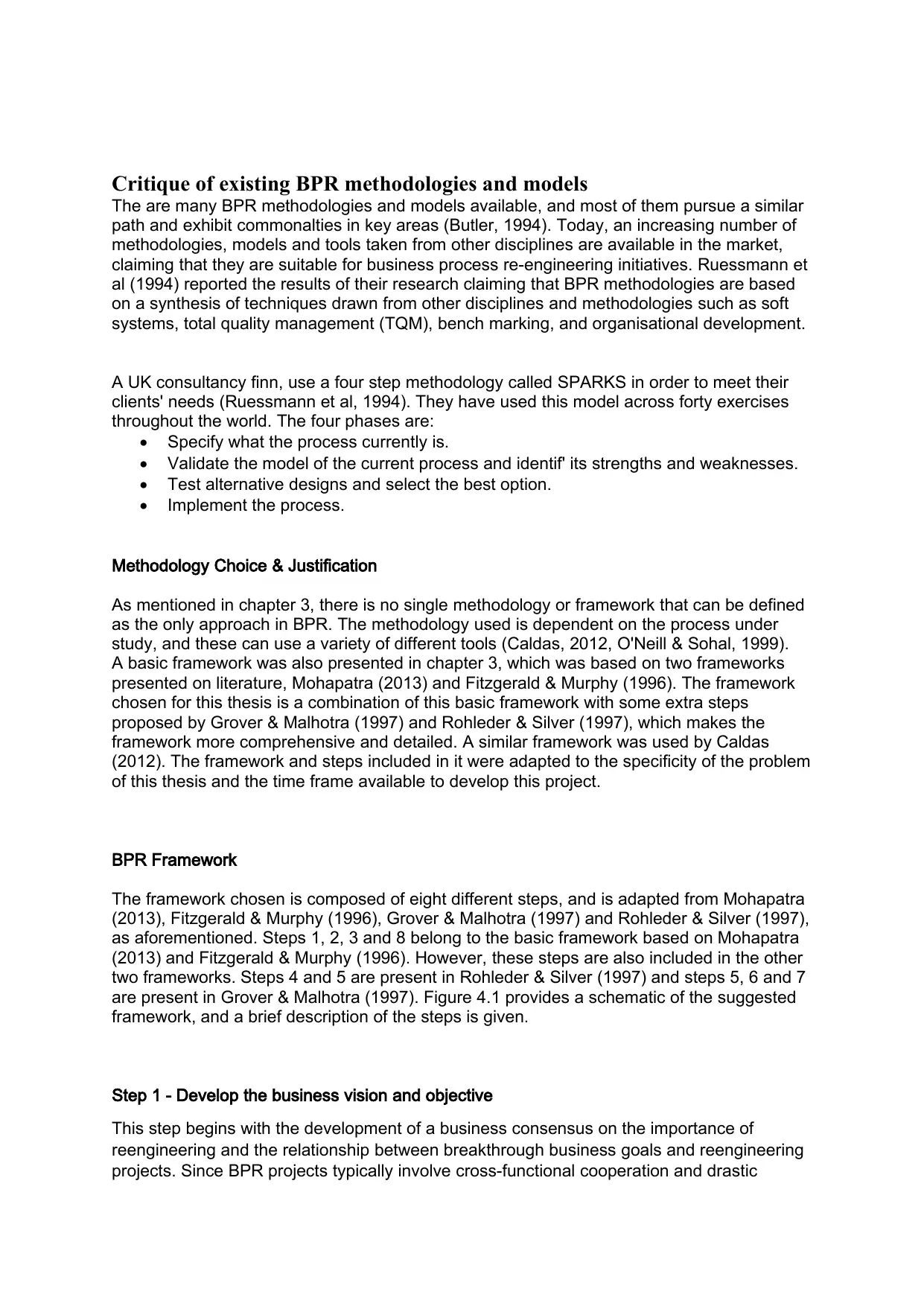
Critique of existing BPR methodologies and models
The are many BPR methodologies and models available, and most of them pursue a similar
path and exhibit commonalties in key areas (Butler, 1994). Today, an increasing number of
methodologies, models and tools taken from other disciplines are available in the market,
claiming that they are suitable for business process re-engineering initiatives. Ruessmann et
al (1994) reported the results of their research claiming that BPR methodologies are based
on a synthesis of techniques drawn from other disciplines and methodologies such as soft
systems, total quality management (TQM), bench marking, and organisational development.
A UK consultancy finn, use a four step methodology called SPARKS in order to meet their
clients' needs (Ruessmann et al, 1994). They have used this model across forty exercises
throughout the world. The four phases are:
Specify what the process currently is.
Validate the model of the current process and identif' its strengths and weaknesses.
Test alternative designs and select the best option.
Implement the process.
Methodology Choice & Justification
As mentioned in chapter 3, there is no single methodology or framework that can be defined
as the only approach in BPR. The methodology used is dependent on the process under
study, and these can use a variety of different tools (Caldas, 2012, O'Neill & Sohal, 1999).
A basic framework was also presented in chapter 3, which was based on two frameworks
presented on literature, Mohapatra (2013) and Fitzgerald & Murphy (1996). The framework
chosen for this thesis is a combination of this basic framework with some extra steps
proposed by Grover & Malhotra (1997) and Rohleder & Silver (1997), which makes the
framework more comprehensive and detailed. A similar framework was used by Caldas
(2012). The framework and steps included in it were adapted to the specificity of the problem
of this thesis and the time frame available to develop this project.
BPR Framework
The framework chosen is composed of eight different steps, and is adapted from Mohapatra
(2013), Fitzgerald & Murphy (1996), Grover & Malhotra (1997) and Rohleder & Silver (1997),
as aforementioned. Steps 1, 2, 3 and 8 belong to the basic framework based on Mohapatra
(2013) and Fitzgerald & Murphy (1996). However, these steps are also included in the other
two frameworks. Steps 4 and 5 are present in Rohleder & Silver (1997) and steps 5, 6 and 7
are present in Grover & Malhotra (1997). Figure 4.1 provides a schematic of the suggested
framework, and a brief description of the steps is given.
Step 1 - Develop the business vision and objective
This step begins with the development of a business consensus on the importance of
reengineering and the relationship between breakthrough business goals and reengineering
projects. Since BPR projects typically involve cross-functional cooperation and drastic
The are many BPR methodologies and models available, and most of them pursue a similar
path and exhibit commonalties in key areas (Butler, 1994). Today, an increasing number of
methodologies, models and tools taken from other disciplines are available in the market,
claiming that they are suitable for business process re-engineering initiatives. Ruessmann et
al (1994) reported the results of their research claiming that BPR methodologies are based
on a synthesis of techniques drawn from other disciplines and methodologies such as soft
systems, total quality management (TQM), bench marking, and organisational development.
A UK consultancy finn, use a four step methodology called SPARKS in order to meet their
clients' needs (Ruessmann et al, 1994). They have used this model across forty exercises
throughout the world. The four phases are:
Specify what the process currently is.
Validate the model of the current process and identif' its strengths and weaknesses.
Test alternative designs and select the best option.
Implement the process.
Methodology Choice & Justification
As mentioned in chapter 3, there is no single methodology or framework that can be defined
as the only approach in BPR. The methodology used is dependent on the process under
study, and these can use a variety of different tools (Caldas, 2012, O'Neill & Sohal, 1999).
A basic framework was also presented in chapter 3, which was based on two frameworks
presented on literature, Mohapatra (2013) and Fitzgerald & Murphy (1996). The framework
chosen for this thesis is a combination of this basic framework with some extra steps
proposed by Grover & Malhotra (1997) and Rohleder & Silver (1997), which makes the
framework more comprehensive and detailed. A similar framework was used by Caldas
(2012). The framework and steps included in it were adapted to the specificity of the problem
of this thesis and the time frame available to develop this project.
BPR Framework
The framework chosen is composed of eight different steps, and is adapted from Mohapatra
(2013), Fitzgerald & Murphy (1996), Grover & Malhotra (1997) and Rohleder & Silver (1997),
as aforementioned. Steps 1, 2, 3 and 8 belong to the basic framework based on Mohapatra
(2013) and Fitzgerald & Murphy (1996). However, these steps are also included in the other
two frameworks. Steps 4 and 5 are present in Rohleder & Silver (1997) and steps 5, 6 and 7
are present in Grover & Malhotra (1997). Figure 4.1 provides a schematic of the suggested
framework, and a brief description of the steps is given.
Step 1 - Develop the business vision and objective
This step begins with the development of a business consensus on the importance of
reengineering and the relationship between breakthrough business goals and reengineering
projects. Since BPR projects typically involve cross-functional cooperation and drastic
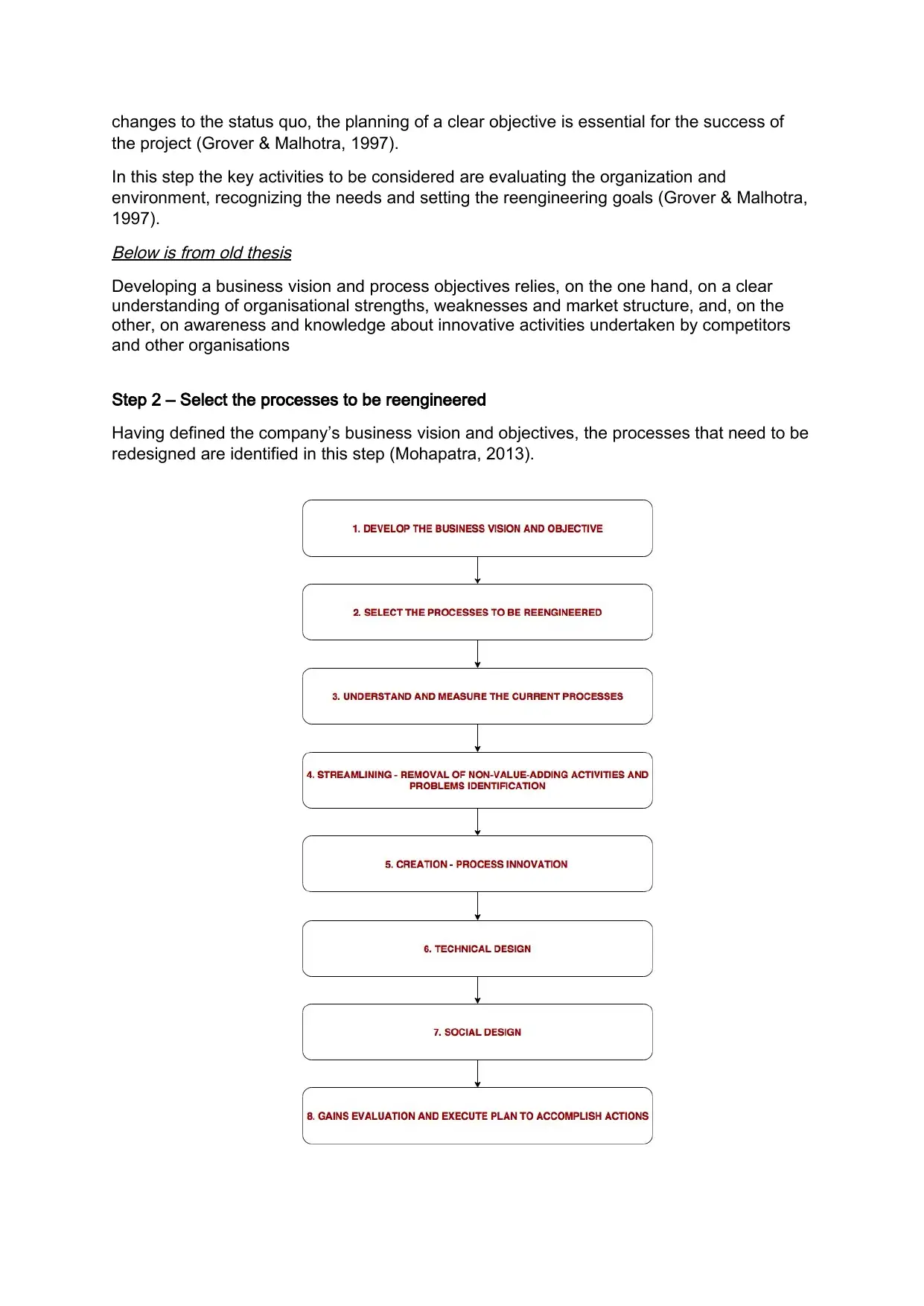
changes to the status quo, the planning of a clear objective is essential for the success of
the project (Grover & Malhotra, 1997).
In this step the key activities to be considered are evaluating the organization and
environment, recognizing the needs and setting the reengineering goals (Grover & Malhotra,
1997).Below is from old thesis
Developing a business vision and process objectives relies, on the one hand, on a clear
understanding of organisational strengths, weaknesses and market structure, and, on the
other, on awareness and knowledge about innovative activities undertaken by competitors
and other organisations
Step 2 – Select the processes to be reengineered
Having defined the company’s business vision and objectives, the processes that need to be
redesigned are identified in this step (Mohapatra, 2013).
the project (Grover & Malhotra, 1997).
In this step the key activities to be considered are evaluating the organization and
environment, recognizing the needs and setting the reengineering goals (Grover & Malhotra,
1997).Below is from old thesis
Developing a business vision and process objectives relies, on the one hand, on a clear
understanding of organisational strengths, weaknesses and market structure, and, on the
other, on awareness and knowledge about innovative activities undertaken by competitors
and other organisations
Step 2 – Select the processes to be reengineered
Having defined the company’s business vision and objectives, the processes that need to be
redesigned are identified in this step (Mohapatra, 2013).
Paraphrase This Document
Need a fresh take? Get an instant paraphrase of this document with our AI Paraphraser
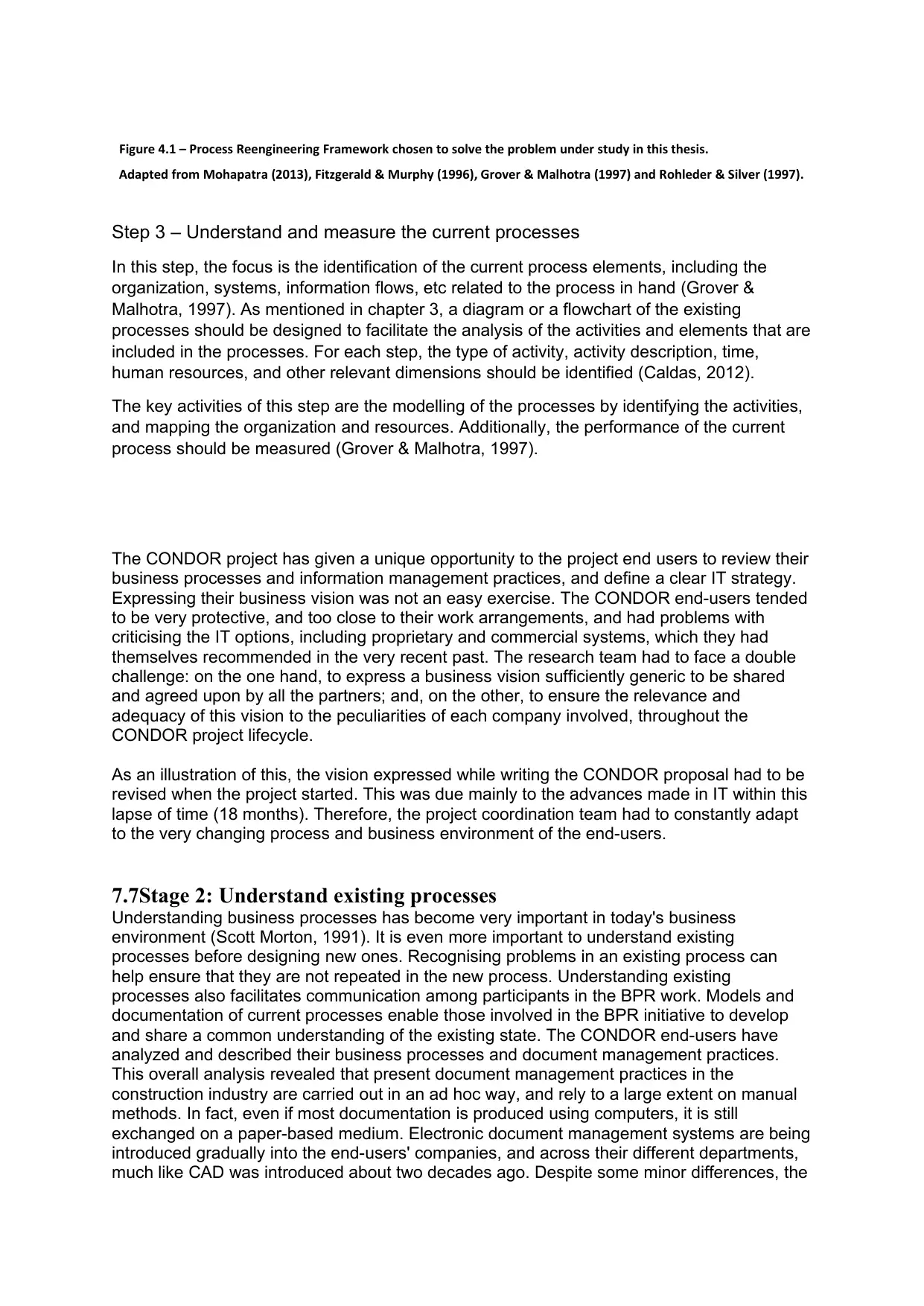
Figure 4.1 – Process Reengineering Framework chosen to solve the problem under study in this thesis.
Adapted from Mohapatra (2013), Fitzgerald & Murphy (1996), Grover & Malhotra (1997) and Rohleder & Silver (1997).
Step 3 – Understand and measure the current processes
In this step, the focus is the identification of the current process elements, including the
organization, systems, information flows, etc related to the process in hand (Grover &
Malhotra, 1997). As mentioned in chapter 3, a diagram or a flowchart of the existing
processes should be designed to facilitate the analysis of the activities and elements that are
included in the processes. For each step, the type of activity, activity description, time,
human resources, and other relevant dimensions should be identified (Caldas, 2012).
The key activities of this step are the modelling of the processes by identifying the activities,
and mapping the organization and resources. Additionally, the performance of the current
process should be measured (Grover & Malhotra, 1997).
The CONDOR project has given a unique opportunity to the project end users to review their
business processes and information management practices, and define a clear IT strategy.
Expressing their business vision was not an easy exercise. The CONDOR end-users tended
to be very protective, and too close to their work arrangements, and had problems with
criticising the IT options, including proprietary and commercial systems, which they had
themselves recommended in the very recent past. The research team had to face a double
challenge: on the one hand, to express a business vision sufficiently generic to be shared
and agreed upon by all the partners; and, on the other, to ensure the relevance and
adequacy of this vision to the peculiarities of each company involved, throughout the
CONDOR project lifecycle.
As an illustration of this, the vision expressed while writing the CONDOR proposal had to be
revised when the project started. This was due mainly to the advances made in IT within this
lapse of time (18 months). Therefore, the project coordination team had to constantly adapt
to the very changing process and business environment of the end-users.
7.7Stage 2: Understand existing processes
Understanding business processes has become very important in today's business
environment (Scott Morton, 1991). It is even more important to understand existing
processes before designing new ones. Recognising problems in an existing process can
help ensure that they are not repeated in the new process. Understanding existing
processes also facilitates communication among participants in the BPR work. Models and
documentation of current processes enable those involved in the BPR initiative to develop
and share a common understanding of the existing state. The CONDOR end-users have
analyzed and described their business processes and document management practices.
This overall analysis revealed that present document management practices in the
construction industry are carried out in an ad hoc way, and rely to a large extent on manual
methods. In fact, even if most documentation is produced using computers, it is still
exchanged on a paper-based medium. Electronic document management systems are being
introduced gradually into the end-users' companies, and across their different departments,
much like CAD was introduced about two decades ago. Despite some minor differences, the
Adapted from Mohapatra (2013), Fitzgerald & Murphy (1996), Grover & Malhotra (1997) and Rohleder & Silver (1997).
Step 3 – Understand and measure the current processes
In this step, the focus is the identification of the current process elements, including the
organization, systems, information flows, etc related to the process in hand (Grover &
Malhotra, 1997). As mentioned in chapter 3, a diagram or a flowchart of the existing
processes should be designed to facilitate the analysis of the activities and elements that are
included in the processes. For each step, the type of activity, activity description, time,
human resources, and other relevant dimensions should be identified (Caldas, 2012).
The key activities of this step are the modelling of the processes by identifying the activities,
and mapping the organization and resources. Additionally, the performance of the current
process should be measured (Grover & Malhotra, 1997).
The CONDOR project has given a unique opportunity to the project end users to review their
business processes and information management practices, and define a clear IT strategy.
Expressing their business vision was not an easy exercise. The CONDOR end-users tended
to be very protective, and too close to their work arrangements, and had problems with
criticising the IT options, including proprietary and commercial systems, which they had
themselves recommended in the very recent past. The research team had to face a double
challenge: on the one hand, to express a business vision sufficiently generic to be shared
and agreed upon by all the partners; and, on the other, to ensure the relevance and
adequacy of this vision to the peculiarities of each company involved, throughout the
CONDOR project lifecycle.
As an illustration of this, the vision expressed while writing the CONDOR proposal had to be
revised when the project started. This was due mainly to the advances made in IT within this
lapse of time (18 months). Therefore, the project coordination team had to constantly adapt
to the very changing process and business environment of the end-users.
7.7Stage 2: Understand existing processes
Understanding business processes has become very important in today's business
environment (Scott Morton, 1991). It is even more important to understand existing
processes before designing new ones. Recognising problems in an existing process can
help ensure that they are not repeated in the new process. Understanding existing
processes also facilitates communication among participants in the BPR work. Models and
documentation of current processes enable those involved in the BPR initiative to develop
and share a common understanding of the existing state. The CONDOR end-users have
analyzed and described their business processes and document management practices.
This overall analysis revealed that present document management practices in the
construction industry are carried out in an ad hoc way, and rely to a large extent on manual
methods. In fact, even if most documentation is produced using computers, it is still
exchanged on a paper-based medium. Electronic document management systems are being
introduced gradually into the end-users' companies, and across their different departments,
much like CAD was introduced about two decades ago. Despite some minor differences, the
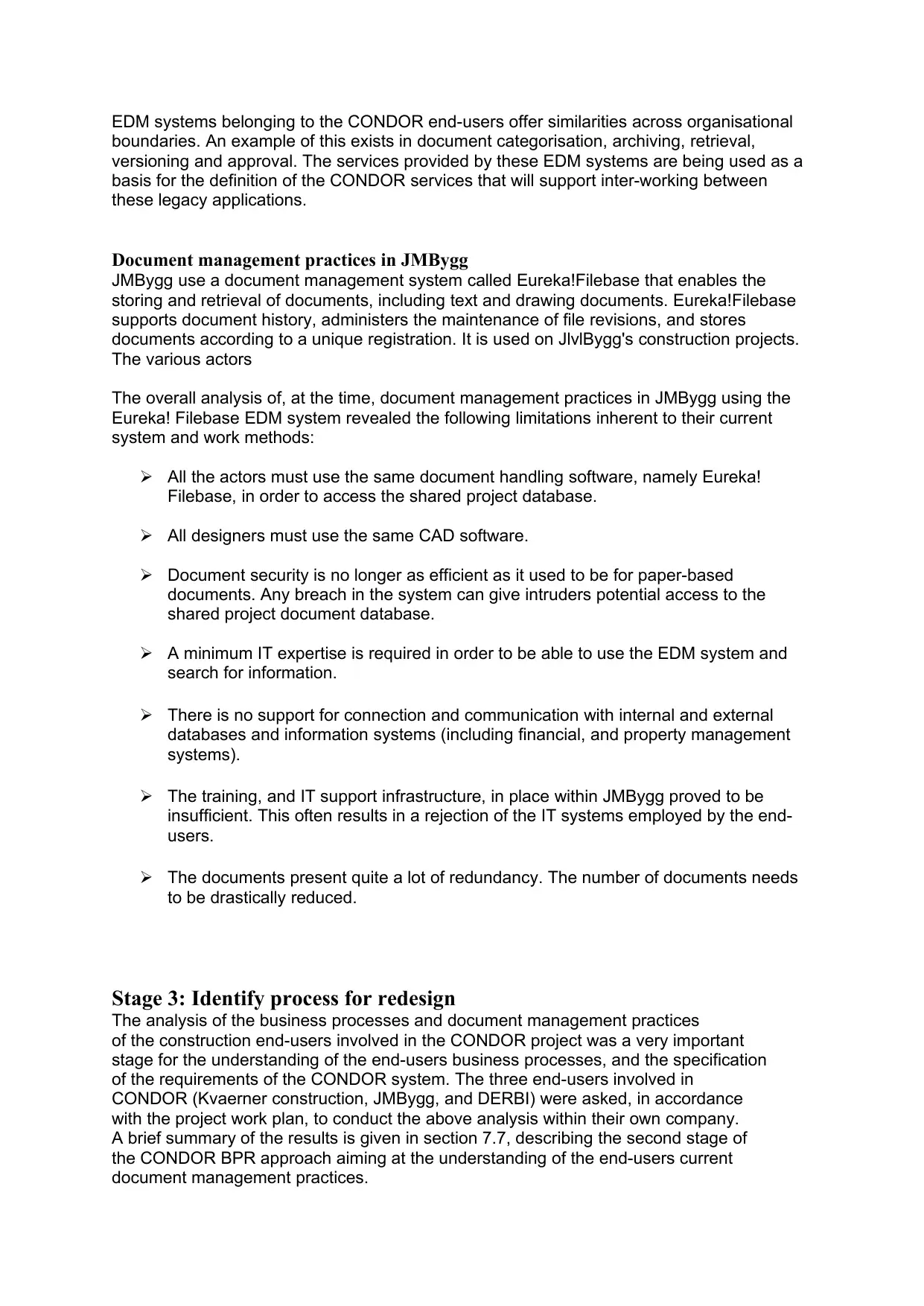
EDM systems belonging to the CONDOR end-users offer similarities across organisational
boundaries. An example of this exists in document categorisation, archiving, retrieval,
versioning and approval. The services provided by these EDM systems are being used as a
basis for the definition of the CONDOR services that will support inter-working between
these legacy applications.
Document management practices in JMBygg
JMBygg use a document management system called Eureka!Filebase that enables the
storing and retrieval of documents, including text and drawing documents. Eureka!Filebase
supports document history, administers the maintenance of file revisions, and stores
documents according to a unique registration. It is used on JlvlBygg's construction projects.
The various actors
The overall analysis of, at the time, document management practices in JMBygg using the
Eureka! Filebase EDM system revealed the following limitations inherent to their current
system and work methods:
All the actors must use the same document handling software, namely Eureka!
Filebase, in order to access the shared project database.
All designers must use the same CAD software.
Document security is no longer as efficient as it used to be for paper-based
documents. Any breach in the system can give intruders potential access to the
shared project document database.
A minimum IT expertise is required in order to be able to use the EDM system and
search for information.
There is no support for connection and communication with internal and external
databases and information systems (including financial, and property management
systems).
The training, and IT support infrastructure, in place within JMBygg proved to be
insufficient. This often results in a rejection of the IT systems employed by the end-
users.
The documents present quite a lot of redundancy. The number of documents needs
to be drastically reduced.
Stage 3: Identify process for redesign
The analysis of the business processes and document management practices
of the construction end-users involved in the CONDOR project was a very important
stage for the understanding of the end-users business processes, and the specification
of the requirements of the CONDOR system. The three end-users involved in
CONDOR (Kvaerner construction, JMBygg, and DERBI) were asked, in accordance
with the project work plan, to conduct the above analysis within their own company.
A brief summary of the results is given in section 7.7, describing the second stage of
the CONDOR BPR approach aiming at the understanding of the end-users current
document management practices.
boundaries. An example of this exists in document categorisation, archiving, retrieval,
versioning and approval. The services provided by these EDM systems are being used as a
basis for the definition of the CONDOR services that will support inter-working between
these legacy applications.
Document management practices in JMBygg
JMBygg use a document management system called Eureka!Filebase that enables the
storing and retrieval of documents, including text and drawing documents. Eureka!Filebase
supports document history, administers the maintenance of file revisions, and stores
documents according to a unique registration. It is used on JlvlBygg's construction projects.
The various actors
The overall analysis of, at the time, document management practices in JMBygg using the
Eureka! Filebase EDM system revealed the following limitations inherent to their current
system and work methods:
All the actors must use the same document handling software, namely Eureka!
Filebase, in order to access the shared project database.
All designers must use the same CAD software.
Document security is no longer as efficient as it used to be for paper-based
documents. Any breach in the system can give intruders potential access to the
shared project document database.
A minimum IT expertise is required in order to be able to use the EDM system and
search for information.
There is no support for connection and communication with internal and external
databases and information systems (including financial, and property management
systems).
The training, and IT support infrastructure, in place within JMBygg proved to be
insufficient. This often results in a rejection of the IT systems employed by the end-
users.
The documents present quite a lot of redundancy. The number of documents needs
to be drastically reduced.
Stage 3: Identify process for redesign
The analysis of the business processes and document management practices
of the construction end-users involved in the CONDOR project was a very important
stage for the understanding of the end-users business processes, and the specification
of the requirements of the CONDOR system. The three end-users involved in
CONDOR (Kvaerner construction, JMBygg, and DERBI) were asked, in accordance
with the project work plan, to conduct the above analysis within their own company.
A brief summary of the results is given in section 7.7, describing the second stage of
the CONDOR BPR approach aiming at the understanding of the end-users current
document management practices.
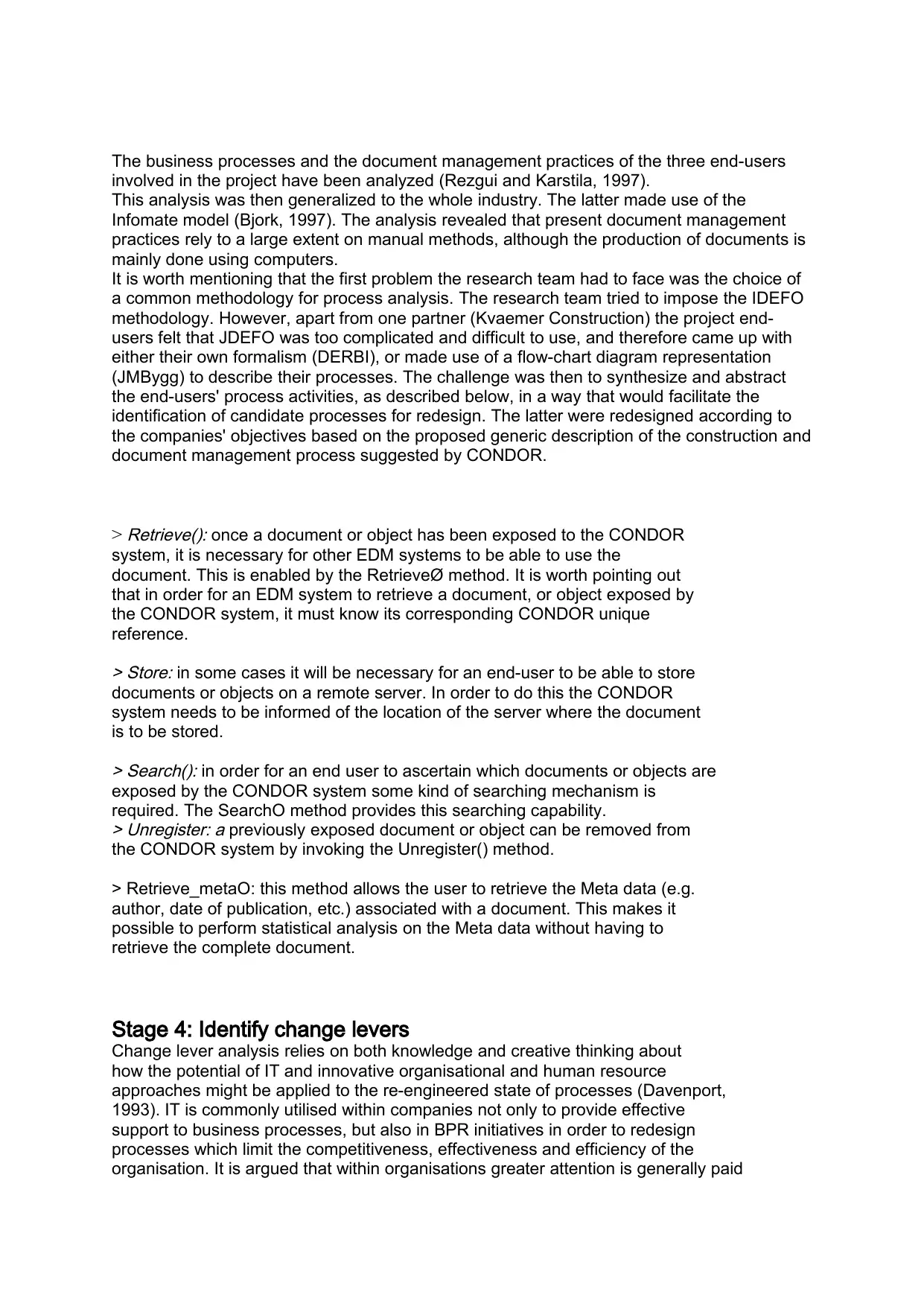
The business processes and the document management practices of the three end-users
involved in the project have been analyzed (Rezgui and Karstila, 1997).
This analysis was then generalized to the whole industry. The latter made use of the
Infomate model (Bjork, 1997). The analysis revealed that present document management
practices rely to a large extent on manual methods, although the production of documents is
mainly done using computers.
It is worth mentioning that the first problem the research team had to face was the choice of
a common methodology for process analysis. The research team tried to impose the IDEFO
methodology. However, apart from one partner (Kvaemer Construction) the project end-
users felt that JDEFO was too complicated and difficult to use, and therefore came up with
either their own formalism (DERBI), or made use of a flow-chart diagram representation
(JMBygg) to describe their processes. The challenge was then to synthesize and abstract
the end-users' process activities, as described below, in a way that would facilitate the
identification of candidate processes for redesign. The latter were redesigned according to
the companies' objectives based on the proposed generic description of the construction and
document management process suggested by CONDOR.
>
Retrieve(): once a document or object has been exposed to the CONDOR
system, it is necessary for other EDM systems to be able to use the
document. This is enabled by the RetrieveØ method. It is worth pointing out
that in order for an EDM system to retrieve a document, or object exposed by
the CONDOR system, it must know its corresponding CONDOR unique
reference.
> Store: in some cases it will be necessary for an end-user to be able to store
documents or objects on a remote server. In order to do this the CONDOR
system needs to be informed of the location of the server where the document
is to be stored.
> Search(): in order for an end user to ascertain which documents or objects are
exposed by the CONDOR system some kind of searching mechanism is
required. The SearchO method provides this searching capability.
> Unregister: a previously exposed document or object can be removed from
the CONDOR system by invoking the Unregister() method.
> Retrieve_metaO: this method allows the user to retrieve the Meta data (e.g.
author, date of publication, etc.) associated with a document. This makes it
possible to perform statistical analysis on the Meta data without having to
retrieve the complete document.
Stage 4: Identify change levers
Change lever analysis relies on both knowledge and creative thinking about
how the potential of IT and innovative organisational and human resource
approaches might be applied to the re-engineered state of processes (Davenport,
1993). IT is commonly utilised within companies not only to provide effective
support to business processes, but also in BPR initiatives in order to redesign
processes which limit the competitiveness, effectiveness and efficiency of the
organisation. It is argued that within organisations greater attention is generally paid
involved in the project have been analyzed (Rezgui and Karstila, 1997).
This analysis was then generalized to the whole industry. The latter made use of the
Infomate model (Bjork, 1997). The analysis revealed that present document management
practices rely to a large extent on manual methods, although the production of documents is
mainly done using computers.
It is worth mentioning that the first problem the research team had to face was the choice of
a common methodology for process analysis. The research team tried to impose the IDEFO
methodology. However, apart from one partner (Kvaemer Construction) the project end-
users felt that JDEFO was too complicated and difficult to use, and therefore came up with
either their own formalism (DERBI), or made use of a flow-chart diagram representation
(JMBygg) to describe their processes. The challenge was then to synthesize and abstract
the end-users' process activities, as described below, in a way that would facilitate the
identification of candidate processes for redesign. The latter were redesigned according to
the companies' objectives based on the proposed generic description of the construction and
document management process suggested by CONDOR.
>
Retrieve(): once a document or object has been exposed to the CONDOR
system, it is necessary for other EDM systems to be able to use the
document. This is enabled by the RetrieveØ method. It is worth pointing out
that in order for an EDM system to retrieve a document, or object exposed by
the CONDOR system, it must know its corresponding CONDOR unique
reference.
> Store: in some cases it will be necessary for an end-user to be able to store
documents or objects on a remote server. In order to do this the CONDOR
system needs to be informed of the location of the server where the document
is to be stored.
> Search(): in order for an end user to ascertain which documents or objects are
exposed by the CONDOR system some kind of searching mechanism is
required. The SearchO method provides this searching capability.
> Unregister: a previously exposed document or object can be removed from
the CONDOR system by invoking the Unregister() method.
> Retrieve_metaO: this method allows the user to retrieve the Meta data (e.g.
author, date of publication, etc.) associated with a document. This makes it
possible to perform statistical analysis on the Meta data without having to
retrieve the complete document.
Stage 4: Identify change levers
Change lever analysis relies on both knowledge and creative thinking about
how the potential of IT and innovative organisational and human resource
approaches might be applied to the re-engineered state of processes (Davenport,
1993). IT is commonly utilised within companies not only to provide effective
support to business processes, but also in BPR initiatives in order to redesign
processes which limit the competitiveness, effectiveness and efficiency of the
organisation. It is argued that within organisations greater attention is generally paid
Secure Best Marks with AI Grader
Need help grading? Try our AI Grader for instant feedback on your assignments.
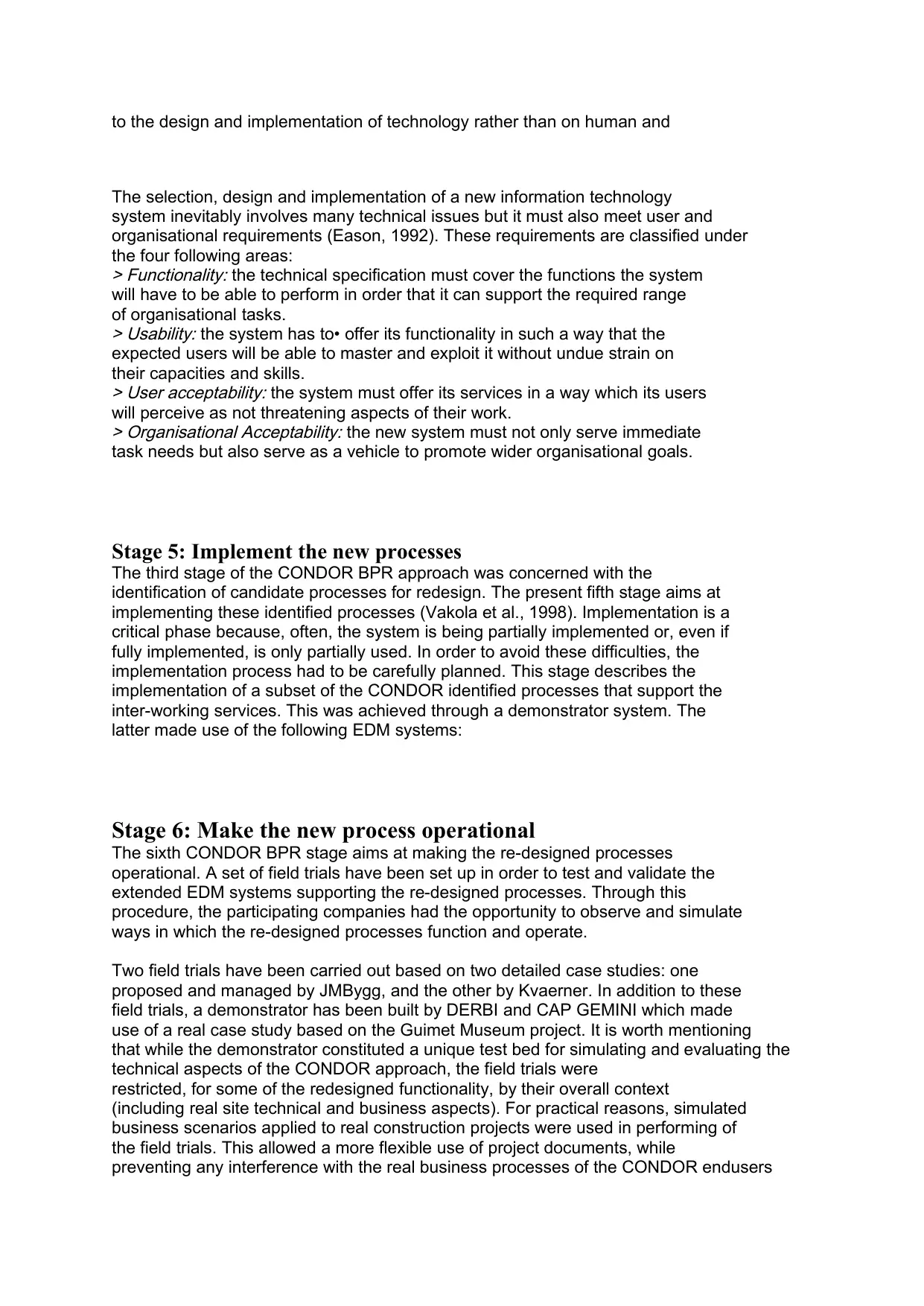
to the design and implementation of technology rather than on human and
The selection, design and implementation of a new information technology
system inevitably involves many technical issues but it must also meet user and
organisational requirements (Eason, 1992). These requirements are classified under
the four following areas:
> Functionality: the technical specification must cover the functions the system
will have to be able to perform in order that it can support the required range
of organisational tasks.
> Usability: the system has to• offer its functionality in such a way that the
expected users will be able to master and exploit it without undue strain on
their capacities and skills.
> User acceptability: the system must offer its services in a way which its users
will perceive as not threatening aspects of their work.
> Organisational Acceptability: the new system must not only serve immediate
task needs but also serve as a vehicle to promote wider organisational goals.
Stage 5: Implement the new processes
The third stage of the CONDOR BPR approach was concerned with the
identification of candidate processes for redesign. The present fifth stage aims at
implementing these identified processes (Vakola et al., 1998). Implementation is a
critical phase because, often, the system is being partially implemented or, even if
fully implemented, is only partially used. In order to avoid these difficulties, the
implementation process had to be carefully planned. This stage describes the
implementation of a subset of the CONDOR identified processes that support the
inter-working services. This was achieved through a demonstrator system. The
latter made use of the following EDM systems:
Stage 6: Make the new process operational
The sixth CONDOR BPR stage aims at making the re-designed processes
operational. A set of field trials have been set up in order to test and validate the
extended EDM systems supporting the re-designed processes. Through this
procedure, the participating companies had the opportunity to observe and simulate
ways in which the re-designed processes function and operate.
Two field trials have been carried out based on two detailed case studies: one
proposed and managed by JMBygg, and the other by Kvaerner. In addition to these
field trials, a demonstrator has been built by DERBI and CAP GEMINI which made
use of a real case study based on the Guimet Museum project. It is worth mentioning
that while the demonstrator constituted a unique test bed for simulating and evaluating the
technical aspects of the CONDOR approach, the field trials were
restricted, for some of the redesigned functionality, by their overall context
(including real site technical and business aspects). For practical reasons, simulated
business scenarios applied to real construction projects were used in performing of
the field trials. This allowed a more flexible use of project documents, while
preventing any interference with the real business processes of the CONDOR endusers
The selection, design and implementation of a new information technology
system inevitably involves many technical issues but it must also meet user and
organisational requirements (Eason, 1992). These requirements are classified under
the four following areas:
> Functionality: the technical specification must cover the functions the system
will have to be able to perform in order that it can support the required range
of organisational tasks.
> Usability: the system has to• offer its functionality in such a way that the
expected users will be able to master and exploit it without undue strain on
their capacities and skills.
> User acceptability: the system must offer its services in a way which its users
will perceive as not threatening aspects of their work.
> Organisational Acceptability: the new system must not only serve immediate
task needs but also serve as a vehicle to promote wider organisational goals.
Stage 5: Implement the new processes
The third stage of the CONDOR BPR approach was concerned with the
identification of candidate processes for redesign. The present fifth stage aims at
implementing these identified processes (Vakola et al., 1998). Implementation is a
critical phase because, often, the system is being partially implemented or, even if
fully implemented, is only partially used. In order to avoid these difficulties, the
implementation process had to be carefully planned. This stage describes the
implementation of a subset of the CONDOR identified processes that support the
inter-working services. This was achieved through a demonstrator system. The
latter made use of the following EDM systems:
Stage 6: Make the new process operational
The sixth CONDOR BPR stage aims at making the re-designed processes
operational. A set of field trials have been set up in order to test and validate the
extended EDM systems supporting the re-designed processes. Through this
procedure, the participating companies had the opportunity to observe and simulate
ways in which the re-designed processes function and operate.
Two field trials have been carried out based on two detailed case studies: one
proposed and managed by JMBygg, and the other by Kvaerner. In addition to these
field trials, a demonstrator has been built by DERBI and CAP GEMINI which made
use of a real case study based on the Guimet Museum project. It is worth mentioning
that while the demonstrator constituted a unique test bed for simulating and evaluating the
technical aspects of the CONDOR approach, the field trials were
restricted, for some of the redesigned functionality, by their overall context
(including real site technical and business aspects). For practical reasons, simulated
business scenarios applied to real construction projects were used in performing of
the field trials. This allowed a more flexible use of project documents, while
preventing any interference with the real business processes of the CONDOR endusers
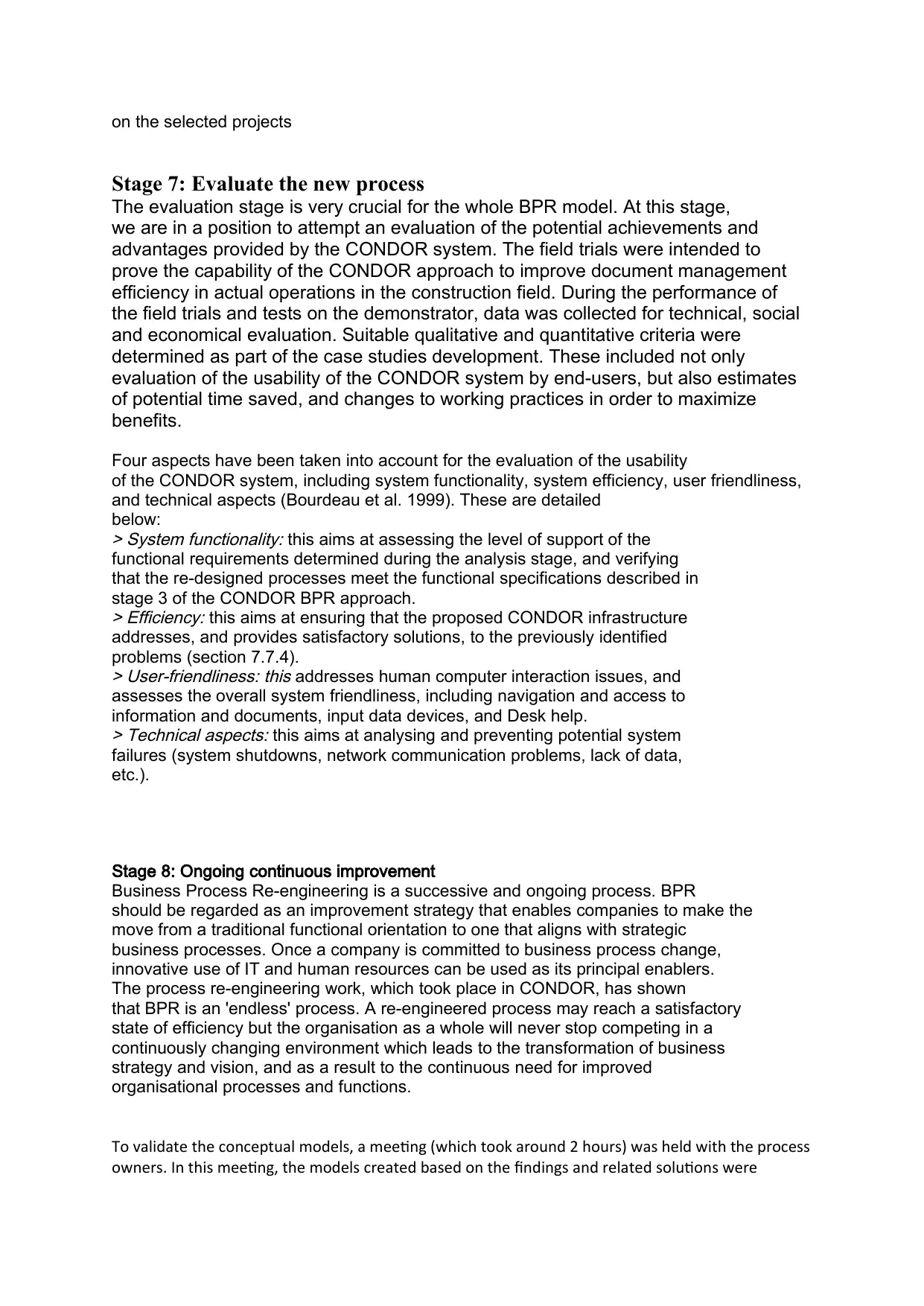
on the selected projects
Stage 7: Evaluate the new process
The evaluation stage is very crucial for the whole BPR model. At this stage,
we are in a position to attempt an evaluation of the potential achievements and
advantages provided by the CONDOR system. The field trials were intended to
prove the capability of the CONDOR approach to improve document management
efficiency in actual operations in the construction field. During the performance of
the field trials and tests on the demonstrator, data was collected for technical, social
and economical evaluation. Suitable qualitative and quantitative criteria were
determined as part of the case studies development. These included not only
evaluation of the usability of the CONDOR system by end-users, but also estimates
of potential time saved, and changes to working practices in order to maximize
benefits.
Four aspects have been taken into account for the evaluation of the usability
of the CONDOR system, including system functionality, system efficiency, user friendliness,
and technical aspects (Bourdeau et al. 1999). These are detailed
below:
> System functionality: this aims at assessing the level of support of the
functional requirements determined during the analysis stage, and verifying
that the re-designed processes meet the functional specifications described in
stage 3 of the CONDOR BPR approach.
> Efficiency: this aims at ensuring that the proposed CONDOR infrastructure
addresses, and provides satisfactory solutions, to the previously identified
problems (section 7.7.4).
> User-friendliness: this addresses human computer interaction issues, and
assesses the overall system friendliness, including navigation and access to
information and documents, input data devices, and Desk help.
> Technical aspects: this aims at analysing and preventing potential system
failures (system shutdowns, network communication problems, lack of data,
etc.).
Stage 8: Ongoing continuous improvement
Business Process Re-engineering is a successive and ongoing process. BPR
should be regarded as an improvement strategy that enables companies to make the
move from a traditional functional orientation to one that aligns with strategic
business processes. Once a company is committed to business process change,
innovative use of IT and human resources can be used as its principal enablers.
The process re-engineering work, which took place in CONDOR, has shown
that BPR is an 'endless' process. A re-engineered process may reach a satisfactory
state of efficiency but the organisation as a whole will never stop competing in a
continuously changing environment which leads to the transformation of business
strategy and vision, and as a result to the continuous need for improved
organisational processes and functions.
To validate the conceptual models, a meeting (which took around 2 hours) was held with the process
owners. In this meeting, the models created based on the findings and related solutions were
Stage 7: Evaluate the new process
The evaluation stage is very crucial for the whole BPR model. At this stage,
we are in a position to attempt an evaluation of the potential achievements and
advantages provided by the CONDOR system. The field trials were intended to
prove the capability of the CONDOR approach to improve document management
efficiency in actual operations in the construction field. During the performance of
the field trials and tests on the demonstrator, data was collected for technical, social
and economical evaluation. Suitable qualitative and quantitative criteria were
determined as part of the case studies development. These included not only
evaluation of the usability of the CONDOR system by end-users, but also estimates
of potential time saved, and changes to working practices in order to maximize
benefits.
Four aspects have been taken into account for the evaluation of the usability
of the CONDOR system, including system functionality, system efficiency, user friendliness,
and technical aspects (Bourdeau et al. 1999). These are detailed
below:
> System functionality: this aims at assessing the level of support of the
functional requirements determined during the analysis stage, and verifying
that the re-designed processes meet the functional specifications described in
stage 3 of the CONDOR BPR approach.
> Efficiency: this aims at ensuring that the proposed CONDOR infrastructure
addresses, and provides satisfactory solutions, to the previously identified
problems (section 7.7.4).
> User-friendliness: this addresses human computer interaction issues, and
assesses the overall system friendliness, including navigation and access to
information and documents, input data devices, and Desk help.
> Technical aspects: this aims at analysing and preventing potential system
failures (system shutdowns, network communication problems, lack of data,
etc.).
Stage 8: Ongoing continuous improvement
Business Process Re-engineering is a successive and ongoing process. BPR
should be regarded as an improvement strategy that enables companies to make the
move from a traditional functional orientation to one that aligns with strategic
business processes. Once a company is committed to business process change,
innovative use of IT and human resources can be used as its principal enablers.
The process re-engineering work, which took place in CONDOR, has shown
that BPR is an 'endless' process. A re-engineered process may reach a satisfactory
state of efficiency but the organisation as a whole will never stop competing in a
continuously changing environment which leads to the transformation of business
strategy and vision, and as a result to the continuous need for improved
organisational processes and functions.
To validate the conceptual models, a meeting (which took around 2 hours) was held with the process
owners. In this meeting, the models created based on the findings and related solutions were
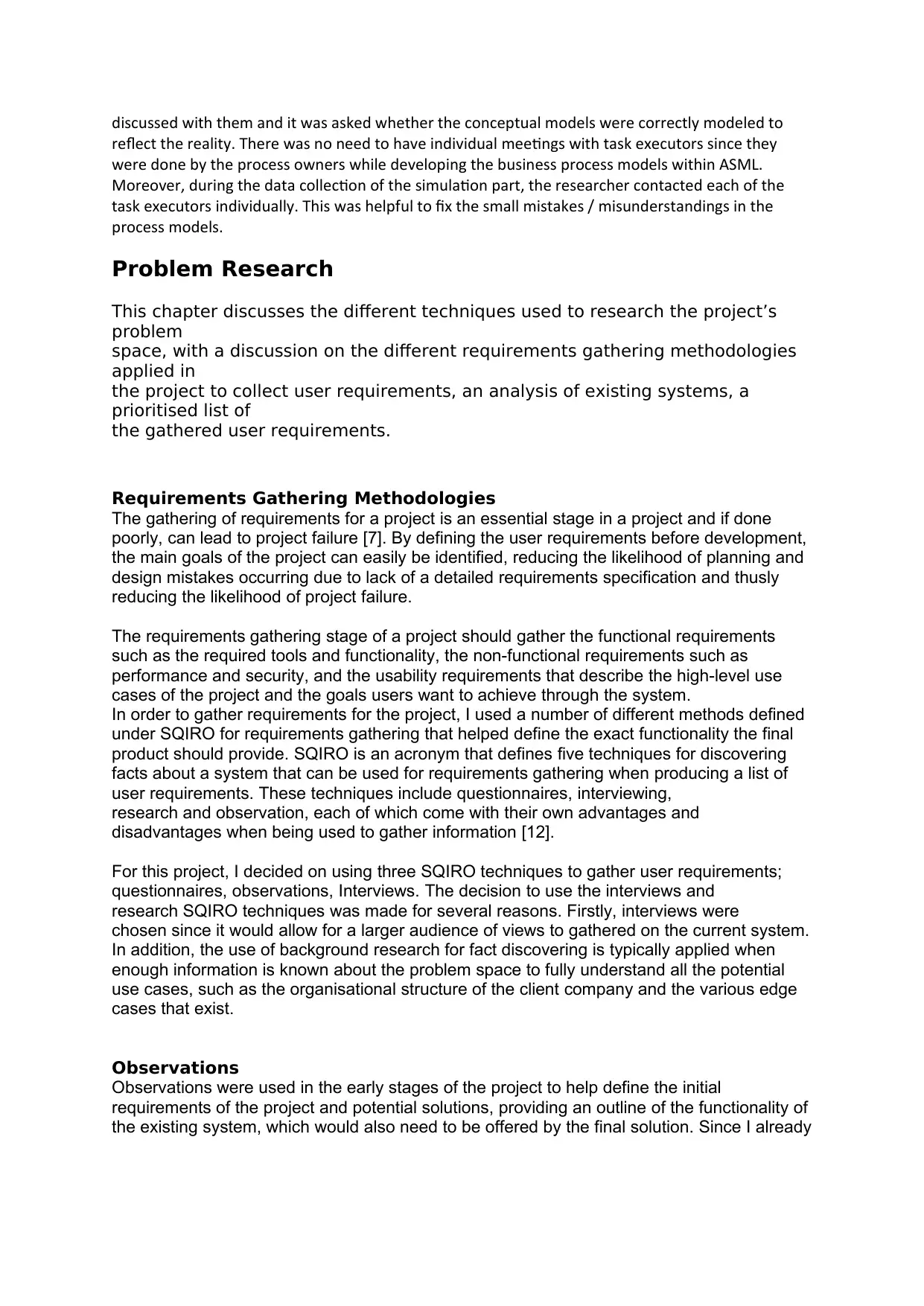
discussed with them and it was asked whether the conceptual models were correctly modeled to
reflect the reality. There was no need to have individual meetings with task executors since they
were done by the process owners while developing the business process models within ASML.
Moreover, during the data collection of the simulation part, the researcher contacted each of the
task executors individually. This was helpful to fix the small mistakes / misunderstandings in the
process models.
Problem Research
This chapter discusses the different techniques used to research the project’s
problem
space, with a discussion on the different requirements gathering methodologies
applied in
the project to collect user requirements, an analysis of existing systems, a
prioritised list of
the gathered user requirements.
Requirements Gathering Methodologies
The gathering of requirements for a project is an essential stage in a project and if done
poorly, can lead to project failure [7]. By defining the user requirements before development,
the main goals of the project can easily be identified, reducing the likelihood of planning and
design mistakes occurring due to lack of a detailed requirements specification and thusly
reducing the likelihood of project failure.
The requirements gathering stage of a project should gather the functional requirements
such as the required tools and functionality, the non-functional requirements such as
performance and security, and the usability requirements that describe the high-level use
cases of the project and the goals users want to achieve through the system.
In order to gather requirements for the project, I used a number of different methods defined
under SQIRO for requirements gathering that helped define the exact functionality the final
product should provide. SQIRO is an acronym that defines five techniques for discovering
facts about a system that can be used for requirements gathering when producing a list of
user requirements. These techniques include questionnaires, interviewing,
research and observation, each of which come with their own advantages and
disadvantages when being used to gather information [12].
For this project, I decided on using three SQIRO techniques to gather user requirements;
questionnaires, observations, Interviews. The decision to use the interviews and
research SQIRO techniques was made for several reasons. Firstly, interviews were
chosen since it would allow for a larger audience of views to gathered on the current system.
In addition, the use of background research for fact discovering is typically applied when
enough information is known about the problem space to fully understand all the potential
use cases, such as the organisational structure of the client company and the various edge
cases that exist.
Observations
Observations were used in the early stages of the project to help define the initial
requirements of the project and potential solutions, providing an outline of the functionality of
the existing system, which would also need to be offered by the final solution. Since I already
reflect the reality. There was no need to have individual meetings with task executors since they
were done by the process owners while developing the business process models within ASML.
Moreover, during the data collection of the simulation part, the researcher contacted each of the
task executors individually. This was helpful to fix the small mistakes / misunderstandings in the
process models.
Problem Research
This chapter discusses the different techniques used to research the project’s
problem
space, with a discussion on the different requirements gathering methodologies
applied in
the project to collect user requirements, an analysis of existing systems, a
prioritised list of
the gathered user requirements.
Requirements Gathering Methodologies
The gathering of requirements for a project is an essential stage in a project and if done
poorly, can lead to project failure [7]. By defining the user requirements before development,
the main goals of the project can easily be identified, reducing the likelihood of planning and
design mistakes occurring due to lack of a detailed requirements specification and thusly
reducing the likelihood of project failure.
The requirements gathering stage of a project should gather the functional requirements
such as the required tools and functionality, the non-functional requirements such as
performance and security, and the usability requirements that describe the high-level use
cases of the project and the goals users want to achieve through the system.
In order to gather requirements for the project, I used a number of different methods defined
under SQIRO for requirements gathering that helped define the exact functionality the final
product should provide. SQIRO is an acronym that defines five techniques for discovering
facts about a system that can be used for requirements gathering when producing a list of
user requirements. These techniques include questionnaires, interviewing,
research and observation, each of which come with their own advantages and
disadvantages when being used to gather information [12].
For this project, I decided on using three SQIRO techniques to gather user requirements;
questionnaires, observations, Interviews. The decision to use the interviews and
research SQIRO techniques was made for several reasons. Firstly, interviews were
chosen since it would allow for a larger audience of views to gathered on the current system.
In addition, the use of background research for fact discovering is typically applied when
enough information is known about the problem space to fully understand all the potential
use cases, such as the organisational structure of the client company and the various edge
cases that exist.
Observations
Observations were used in the early stages of the project to help define the initial
requirements of the project and potential solutions, providing an outline of the functionality of
the existing system, which would also need to be offered by the final solution. Since I already
Paraphrase This Document
Need a fresh take? Get an instant paraphrase of this document with our AI Paraphraser
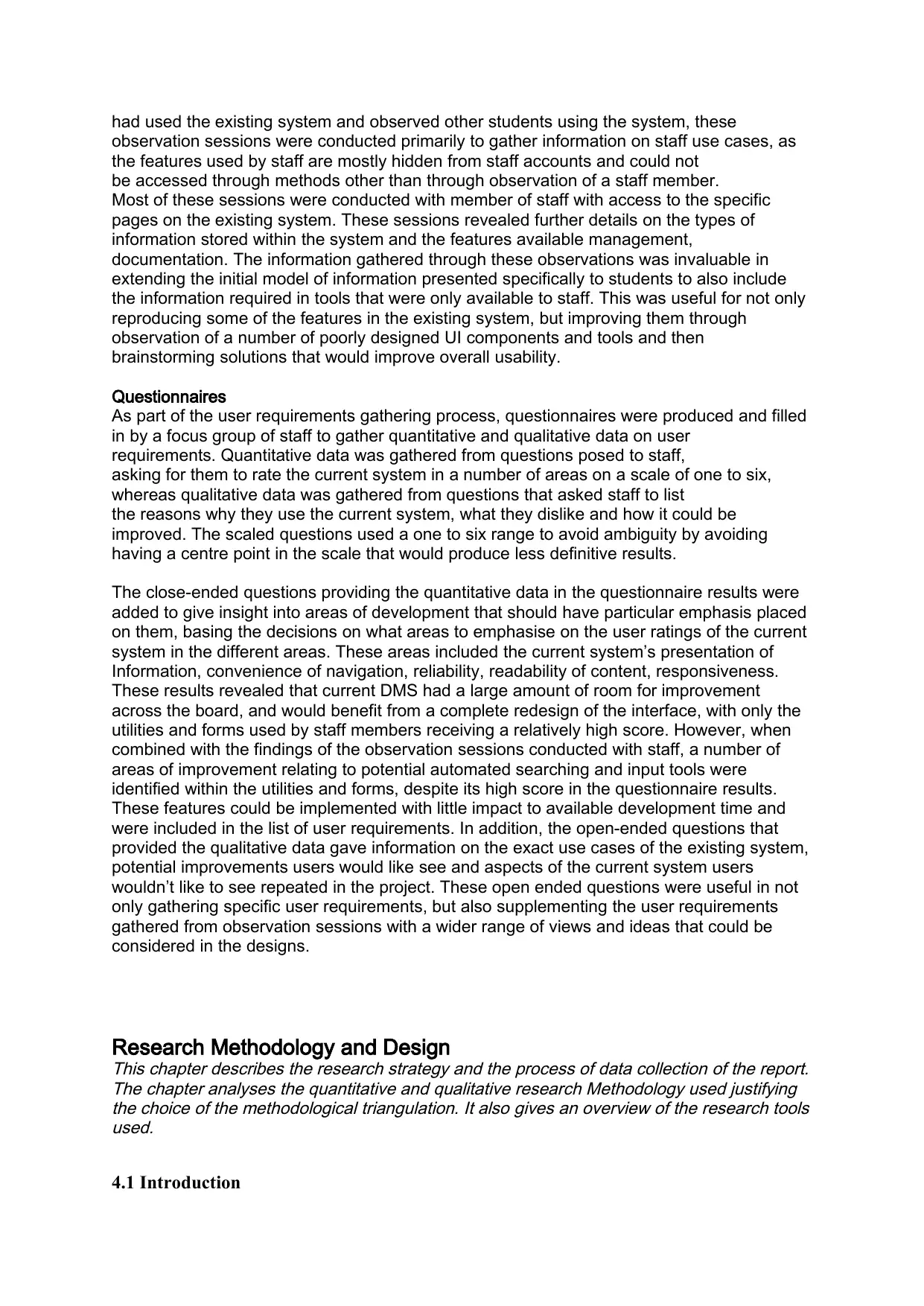
had used the existing system and observed other students using the system, these
observation sessions were conducted primarily to gather information on staff use cases, as
the features used by staff are mostly hidden from staff accounts and could not
be accessed through methods other than through observation of a staff member.
Most of these sessions were conducted with member of staff with access to the specific
pages on the existing system. These sessions revealed further details on the types of
information stored within the system and the features available management,
documentation. The information gathered through these observations was invaluable in
extending the initial model of information presented specifically to students to also include
the information required in tools that were only available to staff. This was useful for not only
reproducing some of the features in the existing system, but improving them through
observation of a number of poorly designed UI components and tools and then
brainstorming solutions that would improve overall usability.
Questionnaires
As part of the user requirements gathering process, questionnaires were produced and filled
in by a focus group of staff to gather quantitative and qualitative data on user
requirements. Quantitative data was gathered from questions posed to staff,
asking for them to rate the current system in a number of areas on a scale of one to six,
whereas qualitative data was gathered from questions that asked staff to list
the reasons why they use the current system, what they dislike and how it could be
improved. The scaled questions used a one to six range to avoid ambiguity by avoiding
having a centre point in the scale that would produce less definitive results.
The close-ended questions providing the quantitative data in the questionnaire results were
added to give insight into areas of development that should have particular emphasis placed
on them, basing the decisions on what areas to emphasise on the user ratings of the current
system in the different areas. These areas included the current system’s presentation of
Information, convenience of navigation, reliability, readability of content, responsiveness.
These results revealed that current DMS had a large amount of room for improvement
across the board, and would benefit from a complete redesign of the interface, with only the
utilities and forms used by staff members receiving a relatively high score. However, when
combined with the findings of the observation sessions conducted with staff, a number of
areas of improvement relating to potential automated searching and input tools were
identified within the utilities and forms, despite its high score in the questionnaire results.
These features could be implemented with little impact to available development time and
were included in the list of user requirements. In addition, the open-ended questions that
provided the qualitative data gave information on the exact use cases of the existing system,
potential improvements users would like see and aspects of the current system users
wouldn’t like to see repeated in the project. These open ended questions were useful in not
only gathering specific user requirements, but also supplementing the user requirements
gathered from observation sessions with a wider range of views and ideas that could be
considered in the designs.
Research Methodology and DesignThis chapter describes the research strategy and the process of data collection of the report.
The chapter analyses the quantitative and qualitative research Methodology used justifying
the choice of the methodological triangulation. It also gives an overview of the research tools
used.
4.1 Introduction
observation sessions were conducted primarily to gather information on staff use cases, as
the features used by staff are mostly hidden from staff accounts and could not
be accessed through methods other than through observation of a staff member.
Most of these sessions were conducted with member of staff with access to the specific
pages on the existing system. These sessions revealed further details on the types of
information stored within the system and the features available management,
documentation. The information gathered through these observations was invaluable in
extending the initial model of information presented specifically to students to also include
the information required in tools that were only available to staff. This was useful for not only
reproducing some of the features in the existing system, but improving them through
observation of a number of poorly designed UI components and tools and then
brainstorming solutions that would improve overall usability.
Questionnaires
As part of the user requirements gathering process, questionnaires were produced and filled
in by a focus group of staff to gather quantitative and qualitative data on user
requirements. Quantitative data was gathered from questions posed to staff,
asking for them to rate the current system in a number of areas on a scale of one to six,
whereas qualitative data was gathered from questions that asked staff to list
the reasons why they use the current system, what they dislike and how it could be
improved. The scaled questions used a one to six range to avoid ambiguity by avoiding
having a centre point in the scale that would produce less definitive results.
The close-ended questions providing the quantitative data in the questionnaire results were
added to give insight into areas of development that should have particular emphasis placed
on them, basing the decisions on what areas to emphasise on the user ratings of the current
system in the different areas. These areas included the current system’s presentation of
Information, convenience of navigation, reliability, readability of content, responsiveness.
These results revealed that current DMS had a large amount of room for improvement
across the board, and would benefit from a complete redesign of the interface, with only the
utilities and forms used by staff members receiving a relatively high score. However, when
combined with the findings of the observation sessions conducted with staff, a number of
areas of improvement relating to potential automated searching and input tools were
identified within the utilities and forms, despite its high score in the questionnaire results.
These features could be implemented with little impact to available development time and
were included in the list of user requirements. In addition, the open-ended questions that
provided the qualitative data gave information on the exact use cases of the existing system,
potential improvements users would like see and aspects of the current system users
wouldn’t like to see repeated in the project. These open ended questions were useful in not
only gathering specific user requirements, but also supplementing the user requirements
gathered from observation sessions with a wider range of views and ideas that could be
considered in the designs.
Research Methodology and DesignThis chapter describes the research strategy and the process of data collection of the report.
The chapter analyses the quantitative and qualitative research Methodology used justifying
the choice of the methodological triangulation. It also gives an overview of the research tools
used.
4.1 Introduction
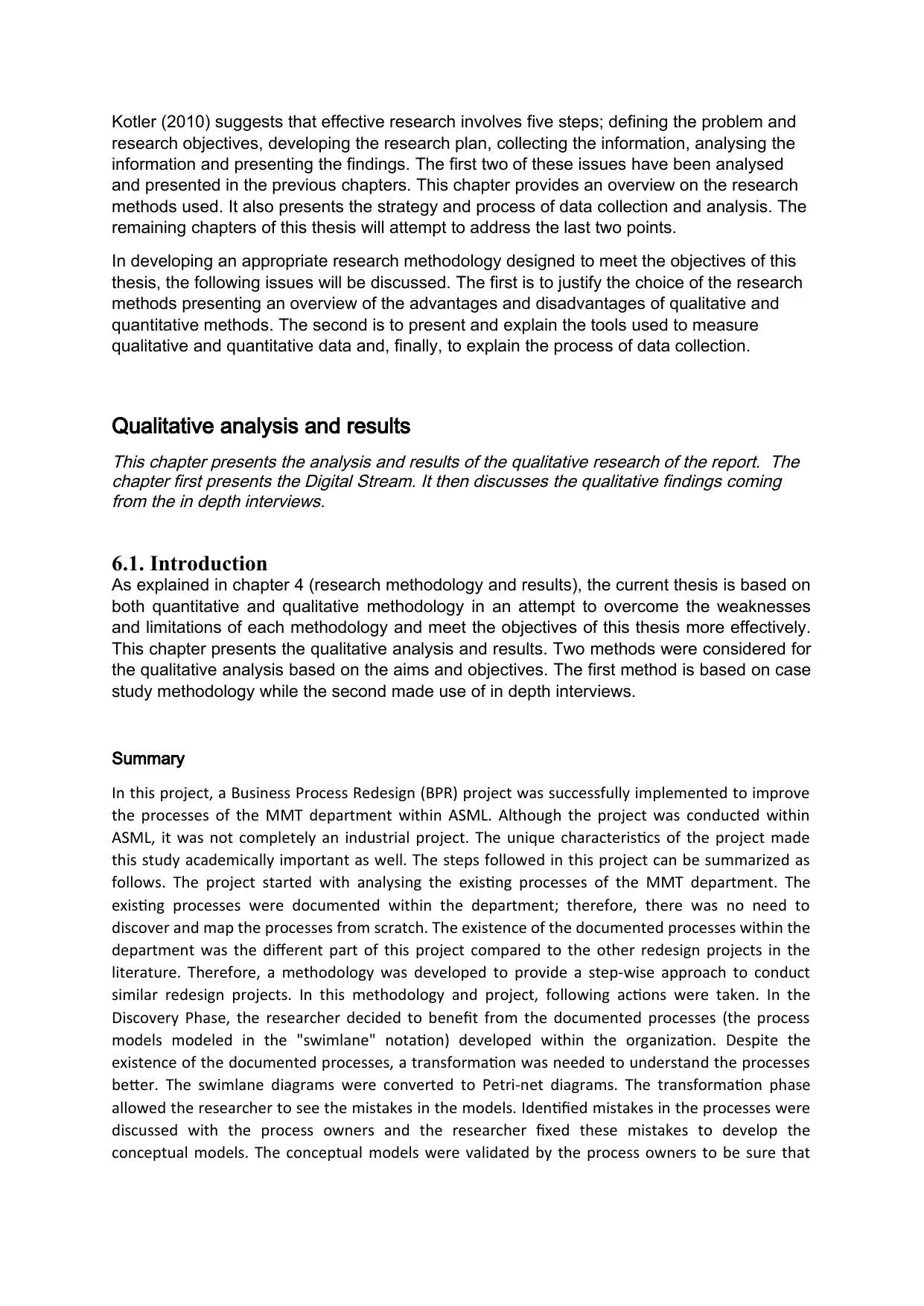
Kotler (2010) suggests that effective research involves five steps; defining the problem and
research objectives, developing the research plan, collecting the information, analysing the
information and presenting the findings. The first two of these issues have been analysed
and presented in the previous chapters. This chapter provides an overview on the research
methods used. It also presents the strategy and process of data collection and analysis. The
remaining chapters of this thesis will attempt to address the last two points.
In developing an appropriate research methodology designed to meet the objectives of this
thesis, the following issues will be discussed. The first is to justify the choice of the research
methods presenting an overview of the advantages and disadvantages of qualitative and
quantitative methods. The second is to present and explain the tools used to measure
qualitative and quantitative data and, finally, to explain the process of data collection.
Qualitative analysis and resultsThis chapter presents the analysis and results of the qualitative research of the report. The
chapter first presents the Digital Stream. It then discusses the qualitative findings coming
from the in depth interviews.
6.1. Introduction
As explained in chapter 4 (research methodology and results), the current thesis is based on
both quantitative and qualitative methodology in an attempt to overcome the weaknesses
and limitations of each methodology and meet the objectives of this thesis more effectively.
This chapter presents the qualitative analysis and results. Two methods were considered for
the qualitative analysis based on the aims and objectives. The first method is based on case
study methodology while the second made use of in depth interviews.
Summary
In this project, a Business Process Redesign (BPR) project was successfully implemented to improve
the processes of the MMT department within ASML. Although the project was conducted within
ASML, it was not completely an industrial project. The unique characteristics of the project made
this study academically important as well. The steps followed in this project can be summarized as
follows. The project started with analysing the existing processes of the MMT department. The
existing processes were documented within the department; therefore, there was no need to
discover and map the processes from scratch. The existence of the documented processes within the
department was the different part of this project compared to the other redesign projects in the
literature. Therefore, a methodology was developed to provide a step-wise approach to conduct
similar redesign projects. In this methodology and project, following actions were taken. In the
Discovery Phase, the researcher decided to benefit from the documented processes (the process
models modeled in the "swimlane" notation) developed within the organization. Despite the
existence of the documented processes, a transformation was needed to understand the processes
better. The swimlane diagrams were converted to Petri-net diagrams. The transformation phase
allowed the researcher to see the mistakes in the models. Identified mistakes in the processes were
discussed with the process owners and the researcher fixed these mistakes to develop the
conceptual models. The conceptual models were validated by the process owners to be sure that
research objectives, developing the research plan, collecting the information, analysing the
information and presenting the findings. The first two of these issues have been analysed
and presented in the previous chapters. This chapter provides an overview on the research
methods used. It also presents the strategy and process of data collection and analysis. The
remaining chapters of this thesis will attempt to address the last two points.
In developing an appropriate research methodology designed to meet the objectives of this
thesis, the following issues will be discussed. The first is to justify the choice of the research
methods presenting an overview of the advantages and disadvantages of qualitative and
quantitative methods. The second is to present and explain the tools used to measure
qualitative and quantitative data and, finally, to explain the process of data collection.
Qualitative analysis and resultsThis chapter presents the analysis and results of the qualitative research of the report. The
chapter first presents the Digital Stream. It then discusses the qualitative findings coming
from the in depth interviews.
6.1. Introduction
As explained in chapter 4 (research methodology and results), the current thesis is based on
both quantitative and qualitative methodology in an attempt to overcome the weaknesses
and limitations of each methodology and meet the objectives of this thesis more effectively.
This chapter presents the qualitative analysis and results. Two methods were considered for
the qualitative analysis based on the aims and objectives. The first method is based on case
study methodology while the second made use of in depth interviews.
Summary
In this project, a Business Process Redesign (BPR) project was successfully implemented to improve
the processes of the MMT department within ASML. Although the project was conducted within
ASML, it was not completely an industrial project. The unique characteristics of the project made
this study academically important as well. The steps followed in this project can be summarized as
follows. The project started with analysing the existing processes of the MMT department. The
existing processes were documented within the department; therefore, there was no need to
discover and map the processes from scratch. The existence of the documented processes within the
department was the different part of this project compared to the other redesign projects in the
literature. Therefore, a methodology was developed to provide a step-wise approach to conduct
similar redesign projects. In this methodology and project, following actions were taken. In the
Discovery Phase, the researcher decided to benefit from the documented processes (the process
models modeled in the "swimlane" notation) developed within the organization. Despite the
existence of the documented processes, a transformation was needed to understand the processes
better. The swimlane diagrams were converted to Petri-net diagrams. The transformation phase
allowed the researcher to see the mistakes in the models. Identified mistakes in the processes were
discussed with the process owners and the researcher fixed these mistakes to develop the
conceptual models. The conceptual models were validated by the process owners to be sure that
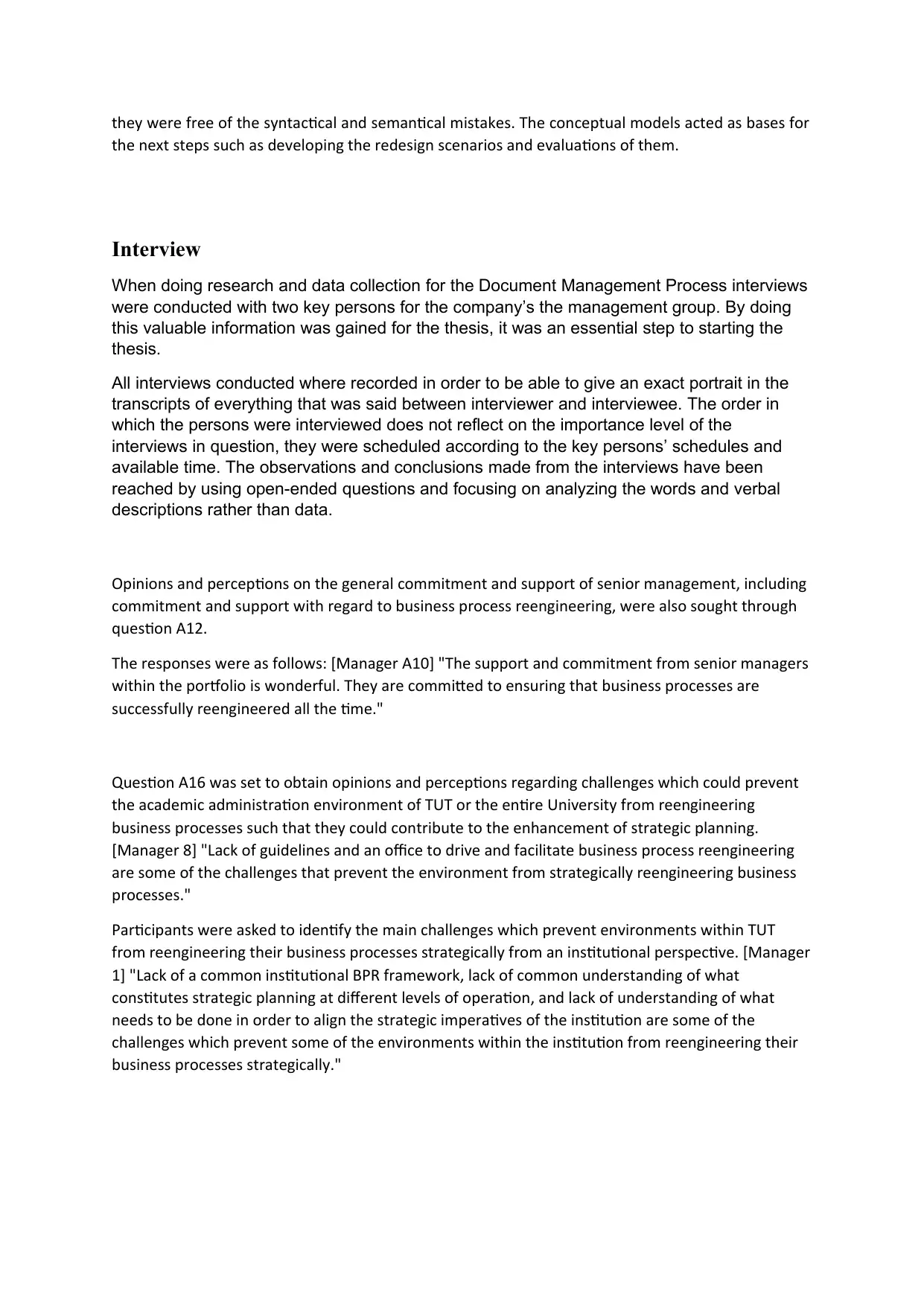
they were free of the syntactical and semantical mistakes. The conceptual models acted as bases for
the next steps such as developing the redesign scenarios and evaluations of them.
Interview
When doing research and data collection for the Document Management Process interviews
were conducted with two key persons for the company’s the management group. By doing
this valuable information was gained for the thesis, it was an essential step to starting the
thesis.
All interviews conducted where recorded in order to be able to give an exact portrait in the
transcripts of everything that was said between interviewer and interviewee. The order in
which the persons were interviewed does not reflect on the importance level of the
interviews in question, they were scheduled according to the key persons’ schedules and
available time. The observations and conclusions made from the interviews have been
reached by using open-ended questions and focusing on analyzing the words and verbal
descriptions rather than data.
Opinions and perceptions on the general commitment and support of senior management, including
commitment and support with regard to business process reengineering, were also sought through
question A12.
The responses were as follows: [Manager A10] "The support and commitment from senior managers
within the portfolio is wonderful. They are committed to ensuring that business processes are
successfully reengineered all the time."
Question A16 was set to obtain opinions and perceptions regarding challenges which could prevent
the academic administration environment of TUT or the entire University from reengineering
business processes such that they could contribute to the enhancement of strategic planning.
[Manager 8] "Lack of guidelines and an office to drive and facilitate business process reengineering
are some of the challenges that prevent the environment from strategically reengineering business
processes."
Participants were asked to identify the main challenges which prevent environments within TUT
from reengineering their business processes strategically from an institutional perspective. [Manager
1] "Lack of a common institutional BPR framework, lack of common understanding of what
constitutes strategic planning at different levels of operation, and lack of understanding of what
needs to be done in order to align the strategic imperatives of the institution are some of the
challenges which prevent some of the environments within the institution from reengineering their
business processes strategically."
the next steps such as developing the redesign scenarios and evaluations of them.
Interview
When doing research and data collection for the Document Management Process interviews
were conducted with two key persons for the company’s the management group. By doing
this valuable information was gained for the thesis, it was an essential step to starting the
thesis.
All interviews conducted where recorded in order to be able to give an exact portrait in the
transcripts of everything that was said between interviewer and interviewee. The order in
which the persons were interviewed does not reflect on the importance level of the
interviews in question, they were scheduled according to the key persons’ schedules and
available time. The observations and conclusions made from the interviews have been
reached by using open-ended questions and focusing on analyzing the words and verbal
descriptions rather than data.
Opinions and perceptions on the general commitment and support of senior management, including
commitment and support with regard to business process reengineering, were also sought through
question A12.
The responses were as follows: [Manager A10] "The support and commitment from senior managers
within the portfolio is wonderful. They are committed to ensuring that business processes are
successfully reengineered all the time."
Question A16 was set to obtain opinions and perceptions regarding challenges which could prevent
the academic administration environment of TUT or the entire University from reengineering
business processes such that they could contribute to the enhancement of strategic planning.
[Manager 8] "Lack of guidelines and an office to drive and facilitate business process reengineering
are some of the challenges that prevent the environment from strategically reengineering business
processes."
Participants were asked to identify the main challenges which prevent environments within TUT
from reengineering their business processes strategically from an institutional perspective. [Manager
1] "Lack of a common institutional BPR framework, lack of common understanding of what
constitutes strategic planning at different levels of operation, and lack of understanding of what
needs to be done in order to align the strategic imperatives of the institution are some of the
challenges which prevent some of the environments within the institution from reengineering their
business processes strategically."
Secure Best Marks with AI Grader
Need help grading? Try our AI Grader for instant feedback on your assignments.
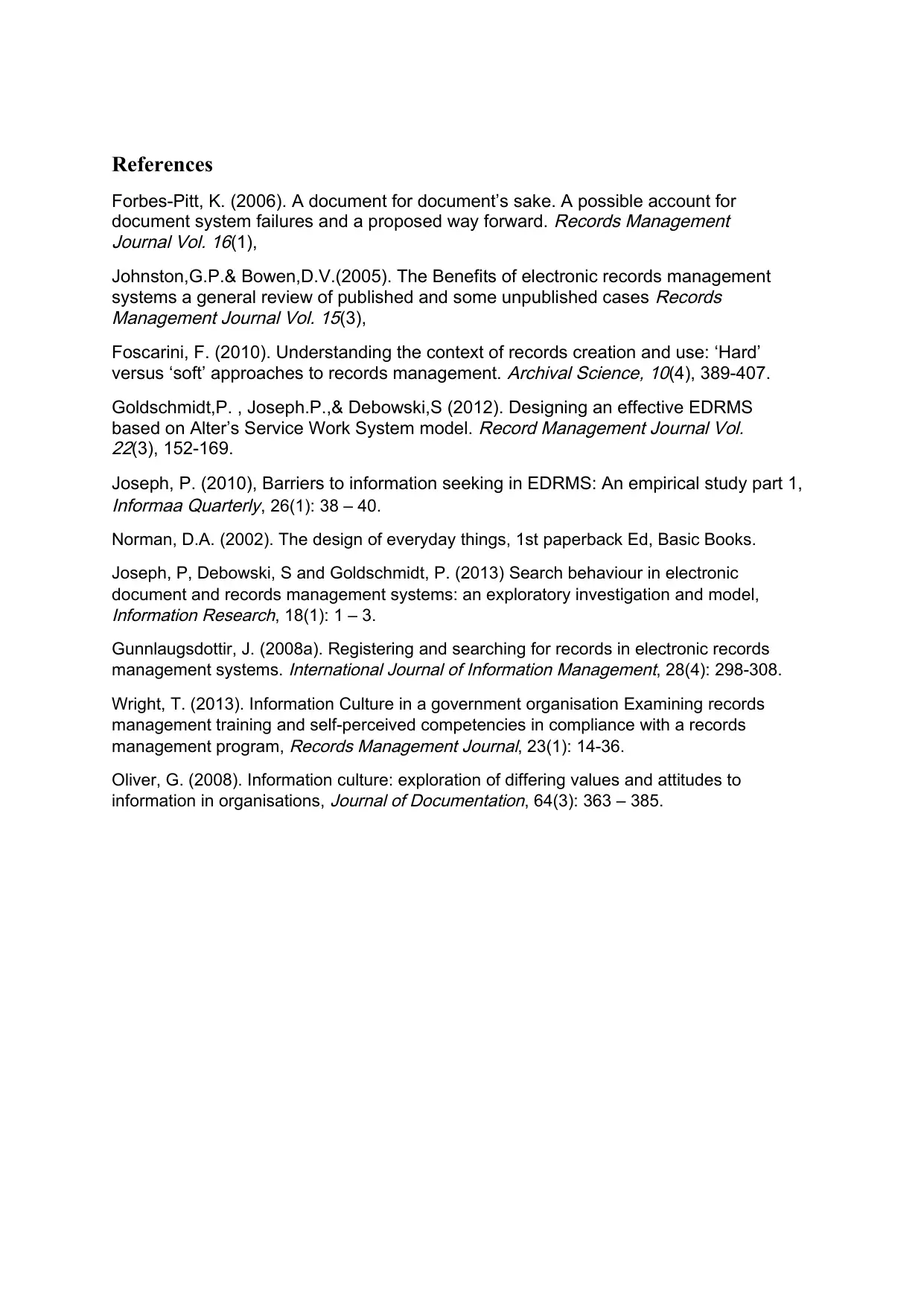
References
Forbes-Pitt, K. (2006). A document for document’s sake. A possible account for
document system failures and a proposed way forward.
Records Management
Journal Vol. 16(1),
Johnston,G.P.& Bowen,D.V.(2005). The Benefits of electronic records management
systems a general review of published and some unpublished cases
Records
Management Journal Vol. 15(3),
Foscarini, F. (2010). Understanding the context of records creation and use: ‘Hard’
versus ‘soft’ approaches to records management.
Archival Science, 10(4), 389-407.
Goldschmidt,P. , Joseph.P.,& Debowski,S (2012). Designing an effective EDRMS
based on Alter’s Service Work System model.
Record Management Journal Vol.
22(3), 152-169.
Joseph, P. (2010), Barriers to information seeking in EDRMS: An empirical study part 1,Informaa Quarterly, 26(1): 38 – 40.
Norman, D.A. (2002). The design of everyday things, 1st paperback Ed, Basic Books.
Joseph, P, Debowski, S and Goldschmidt, P. (2013) Search behaviour in electronic
document and records management systems: an exploratory investigation and model,
Information Research, 18(1): 1 – 3.
Gunnlaugsdottir, J. (2008a). Registering and searching for records in electronic records
management systems.
International Journal of Information Management, 28(4): 298-308.
Wright, T. (2013). Information Culture in a government organisation Examining records
management training and self-perceived competencies in compliance with a records
management program,
Records Management Journal, 23(1): 14-36.
Oliver, G. (2008). Information culture: exploration of differing values and attitudes to
information in organisations,
Journal of Documentation, 64(3): 363 – 385.
Forbes-Pitt, K. (2006). A document for document’s sake. A possible account for
document system failures and a proposed way forward.
Records Management
Journal Vol. 16(1),
Johnston,G.P.& Bowen,D.V.(2005). The Benefits of electronic records management
systems a general review of published and some unpublished cases
Records
Management Journal Vol. 15(3),
Foscarini, F. (2010). Understanding the context of records creation and use: ‘Hard’
versus ‘soft’ approaches to records management.
Archival Science, 10(4), 389-407.
Goldschmidt,P. , Joseph.P.,& Debowski,S (2012). Designing an effective EDRMS
based on Alter’s Service Work System model.
Record Management Journal Vol.
22(3), 152-169.
Joseph, P. (2010), Barriers to information seeking in EDRMS: An empirical study part 1,Informaa Quarterly, 26(1): 38 – 40.
Norman, D.A. (2002). The design of everyday things, 1st paperback Ed, Basic Books.
Joseph, P, Debowski, S and Goldschmidt, P. (2013) Search behaviour in electronic
document and records management systems: an exploratory investigation and model,
Information Research, 18(1): 1 – 3.
Gunnlaugsdottir, J. (2008a). Registering and searching for records in electronic records
management systems.
International Journal of Information Management, 28(4): 298-308.
Wright, T. (2013). Information Culture in a government organisation Examining records
management training and self-perceived competencies in compliance with a records
management program,
Records Management Journal, 23(1): 14-36.
Oliver, G. (2008). Information culture: exploration of differing values and attitudes to
information in organisations,
Journal of Documentation, 64(3): 363 – 385.
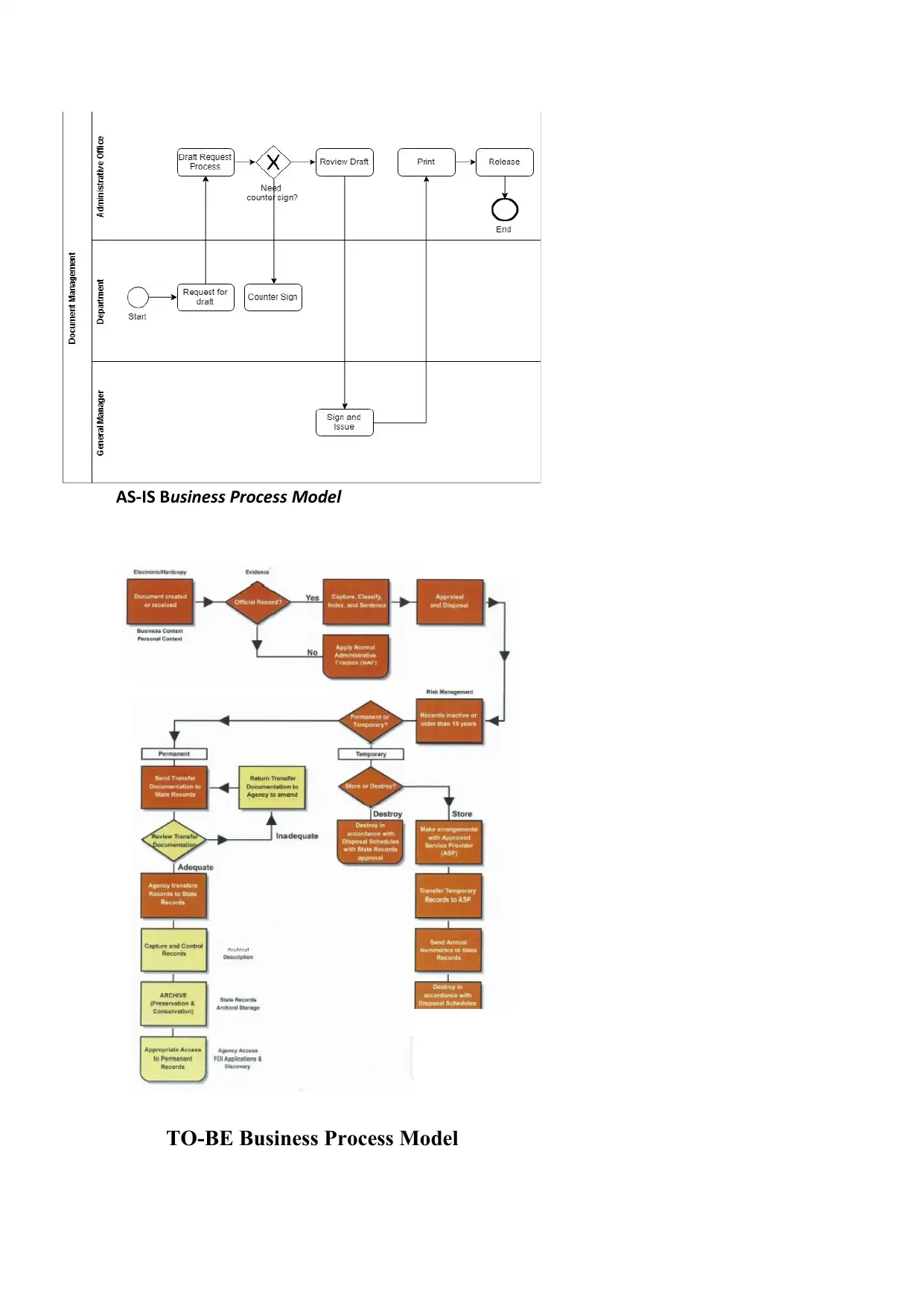
AS-IS Business Process Model
TO-BE Business Process Model
TO-BE Business Process Model
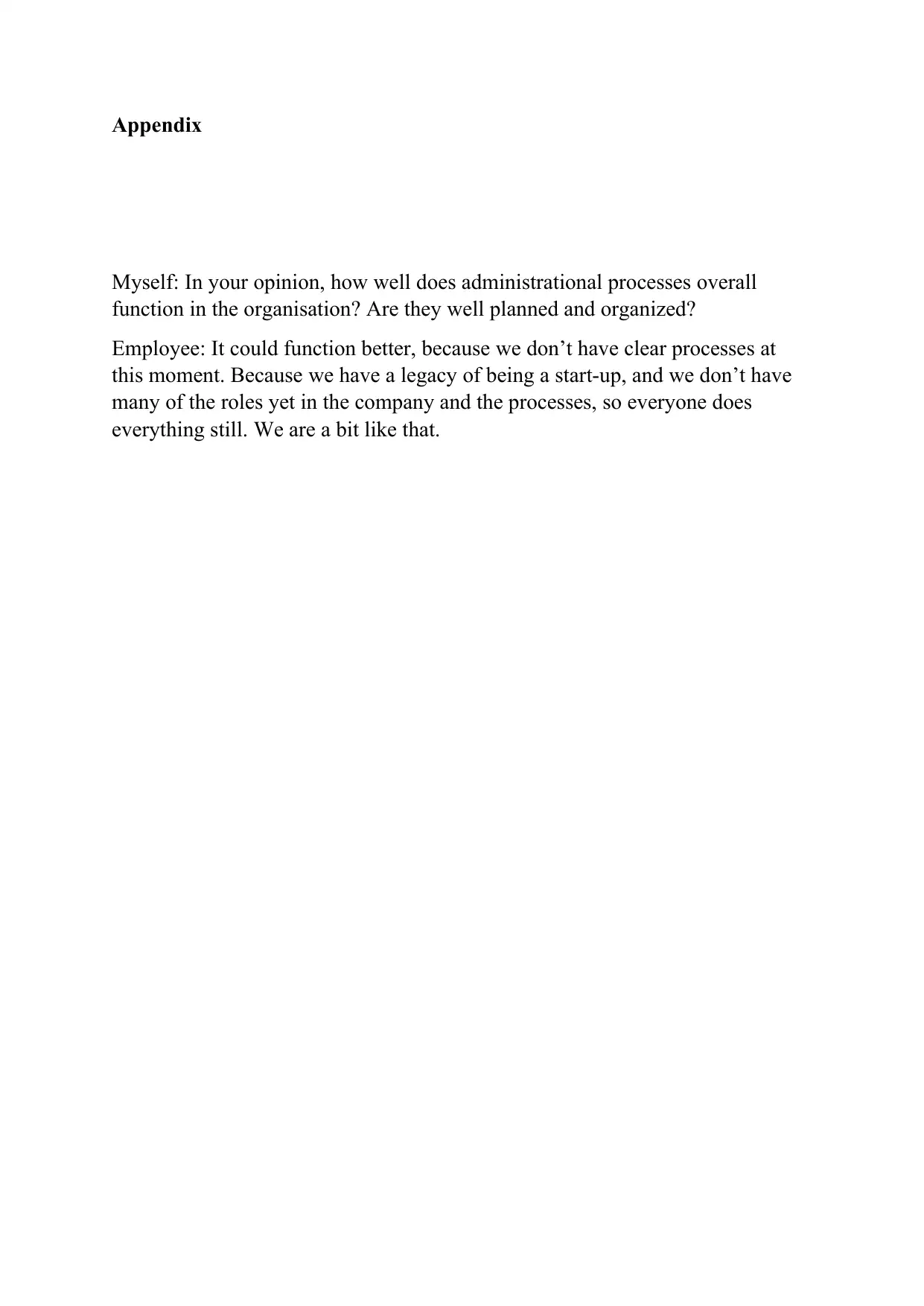
Appendix
Myself: In your opinion, how well does administrational processes overall
function in the organisation? Are they well planned and organized?
Employee: It could function better, because we don’t have clear processes at
this moment. Because we have a legacy of being a start-up, and we don’t have
many of the roles yet in the company and the processes, so everyone does
everything still. We are a bit like that.
Myself: In your opinion, how well does administrational processes overall
function in the organisation? Are they well planned and organized?
Employee: It could function better, because we don’t have clear processes at
this moment. Because we have a legacy of being a start-up, and we don’t have
many of the roles yet in the company and the processes, so everyone does
everything still. We are a bit like that.
1 out of 31
Related Documents
Your All-in-One AI-Powered Toolkit for Academic Success.
+13062052269
info@desklib.com
Available 24*7 on WhatsApp / Email
![[object Object]](/_next/static/media/star-bottom.7253800d.svg)
Unlock your academic potential
© 2024 | Zucol Services PVT LTD | All rights reserved.





